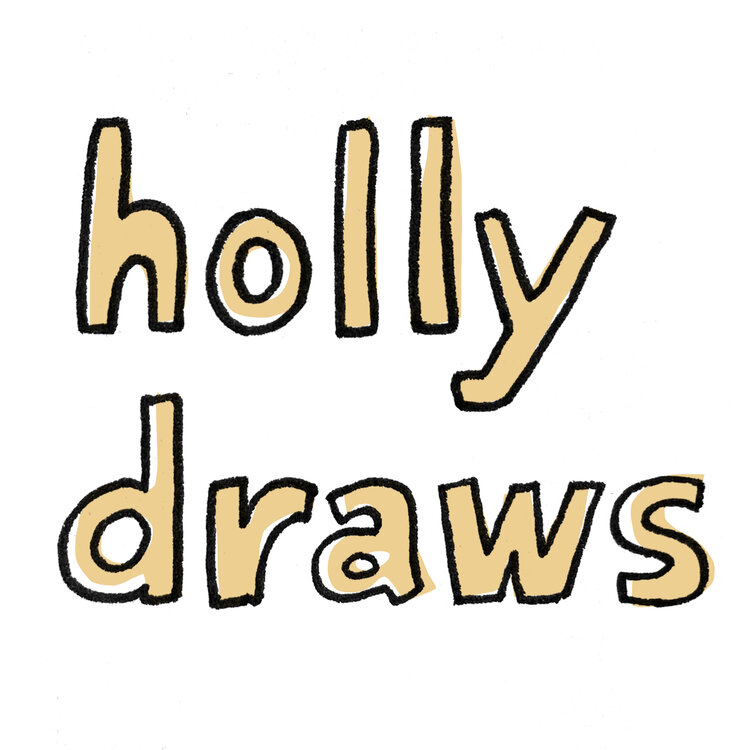
This “people’s park noticeboard” of Victoria Park’s history and its role in the local community is based on responses to a survey conducted by Dr. Karen Jones of Kent University (read more here). The questions asked visitors how often they come to Vicky park, how they use the park, what the park means to them, and what they know about its history.

In July 2021, I got to accompany three great workshops at the first Treescapes conference. The workshops were led respectively by Theresa Bodner, Andrew Heald, and Jenny Knight. I got to hop in and out of the different breakout rooms during each workshop, listening to participants’ thoughts and capturing as much as I could! See the images in more detail here.

This series of images was created in collaboration with Dr. Christian Dunn for an online exhibition on Edinburgh’s future green spaces. We envisioned a future in which bogs are featured and celebrated prominently for their important roles in carbon capture and sequestration as well as water filtration. The exhibition was organised by the British Ecological Society in collaboration with the Edinburgh Science Festival and SMASH-UK.

This series of images was created in collaboration with Dr. Christian Dunn for an online exhibition on Edinburgh’s future green spaces. We envisioned a future in which bogs are featured and celebrated prominently for their important roles in carbon capture and sequestration as well as water filtration. The exhibition was organised by the British Ecological Society in collaboration with the Edinburgh Science Festival and SMASH-UK.

This series of images was created in collaboration with Dr. Christian Dunn for an online exhibition on Edinburgh’s future green spaces. We envisioned a future in which bogs are featured and celebrated prominently for their important roles in carbon capture and sequestration as well as water filtration. The exhibition was organised by the British Ecological Society in collaboration with the Edinburgh Science Festival and SMASH-UK.

I’ve been thinking a lot about roots lately as my apartment fills with houseplants. Each one sits in a separate pot and I find myself asking—do they know that there are other plants around them? Or are their communication pathways cut off by virtue of not sharing the same soil—and the same mycorrhizal networks? This comic for the June issue of The Niche explores just what all those mycorrhizal connections do—and what our houseplants might be missing out on!

“When a group of liberal arts students embark on a university assignment about the natural environment, no one could have quite prepared them for the bewildering array of questions and provocations to confront them in their task.
“What starts out as an earnest attempt to understand nature in the modern world, turns into a philosophical and practical tangle that only a good transdisciplinary education can provide. Can anyone save the day and actually start to value ‘nature’? And if they can’t, then what’s stopping them?”
Illustrated together with Rob Fish, this illustrated graphic guide to valuing nature explores the various frameworks—from economic to social to political to philosophical—that we have traditionally used to define and shape our relationship to nature.
I wrote a blog post when we submitted our final manuscript. You can also find more information about the book under the “books” section on my website, as well as on the publisher’s website here.

A piece for Cara Holland’s “Be A Graphic Recorder” course! This one is a graphic translation, or a visualization of a text (rather than a live recording of a talk). I picked a text by Daniel Potter from KQED on eucalyptus trees in California, which describes their introduction in the 1850s, their subsequent boom as plantation trees, and their fall from grace with accusations of being fire hazards (an accusation that is still debated). I for one melt at the sight and smell of eucalyptus; it seems I belong to that subset of people who would say that its smell is as much the smell of southern California as chaparral is. But it, like many introduced species, is a source of strong emotions and much debate. I enjoyed reading the article and creating this graphic—and, in doing so, giving some thought to novel ecosystems, identity of place, and the way in which we love and define our landscapes by the nature they contain, both old and new.

A mini digital graphic recording I did for the “Be A Graphic Recorder Course” with Cara Holland. I picked an episode of the BBC Earth podcast called “Saving a Species Through Sound“, and challenged myself to stick to about 30 minutes (with a Google window open for quick visual references!!).

My piece for The Niche, September 2020. Low on visuals, high on text. There is so much anti-racist work to be done in the name of achieving equality, and it starts by decolonising our fields – ecology included – and working to make them more inclusive. Here is a link to resources to help support petitions, movements, and calls for change as we fight to reaffirm the essential truth that #BlackLivesMatter.

A piece for the June/July edition of The Niche from the British Ecological Society, reflecting on our relationship to nature from inside during quarantine.
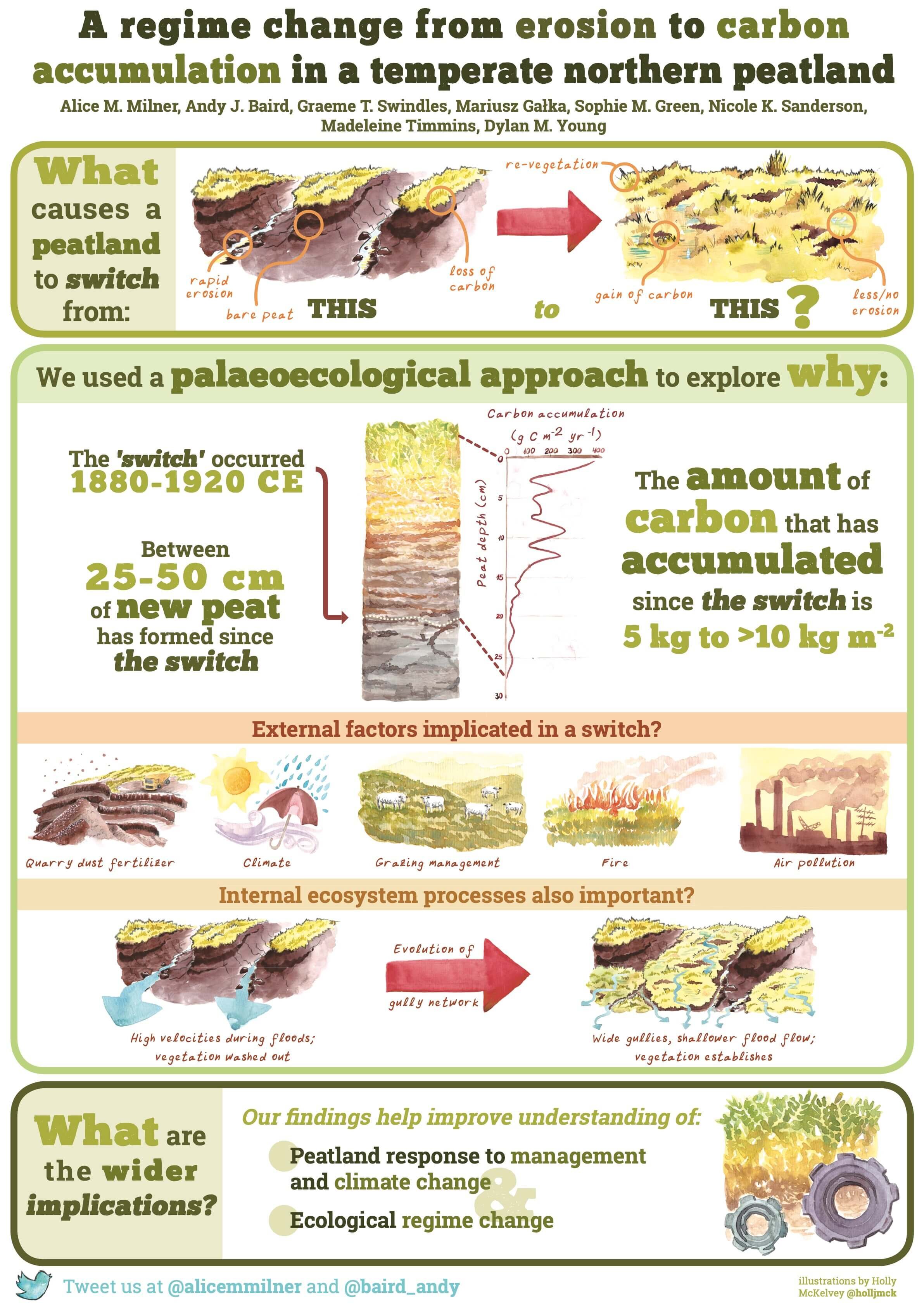
I had the opportunity to do the artwork for this poster on carbon accumulation in peatlands for Alice Milner and Andy Baird for the #INQUADUB19 conference. You can find their paper here.

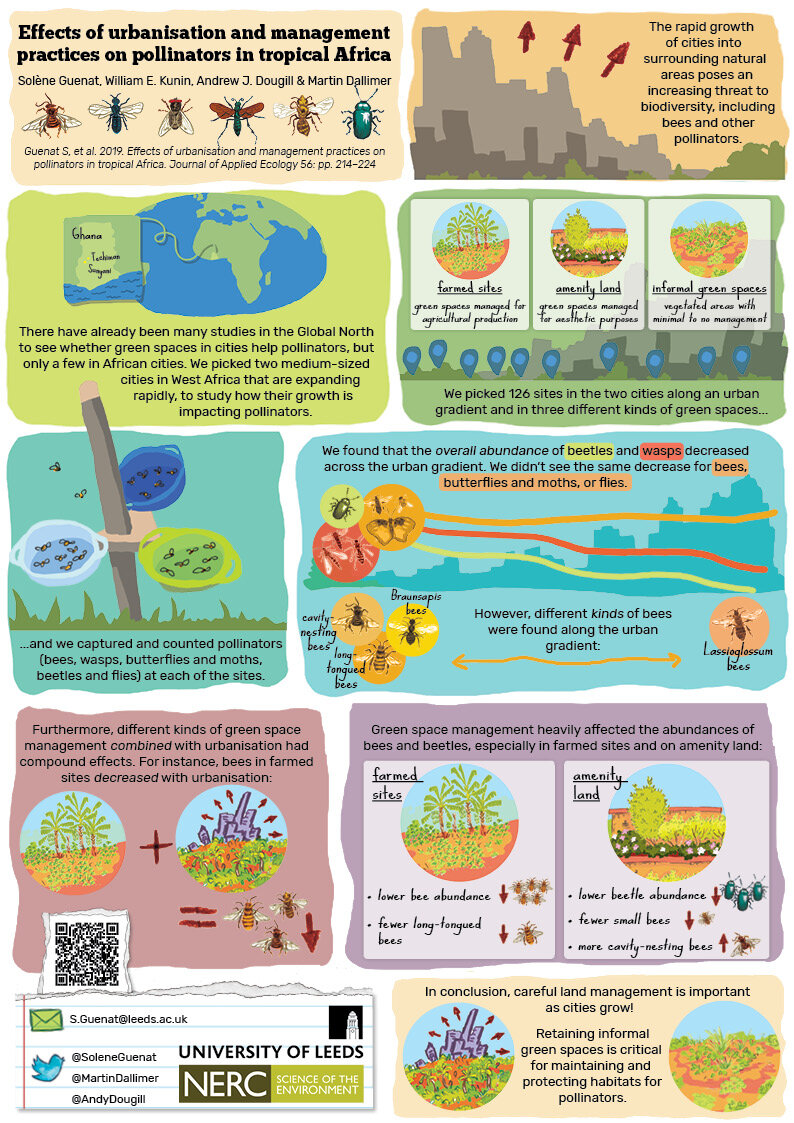
A scicommic I did for Solène Guenat exploring her research on the impacts of urbanisation and greenspace management in two cities in Ghana. You can find the full paper here.

A piece for the March edition of The Niche from the British Ecological Society, touching on the importance of urban nature.
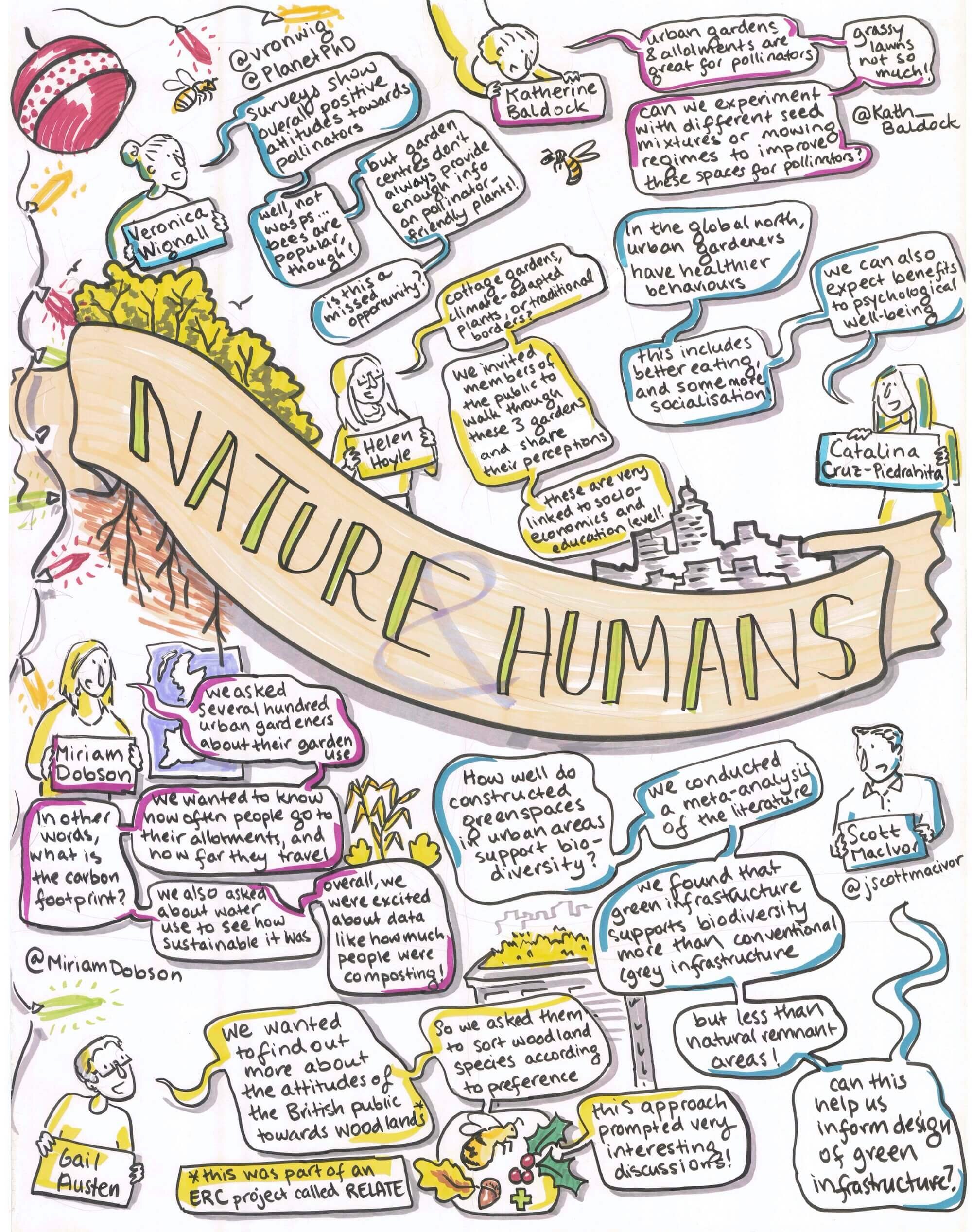
In December 2019 I got to return to my favourite conference of the year – the British Ecological Society (BES) conference, which this year took place in Belfast. I visited sessions on Nature & Humans, Citizen Science, and Harnessing the Data Revolution – a diverse and wonderful range of talks! Check out more of my graphic recording from the event here.

This is a teaser, published in the December issue of The Niche, for an upcoming book that I’m working on in collaboration with Rob Fish from the University of Kent, called “Valuing Nature: The Roots of Transformation”. Stay tuned for more on this book in 2020!
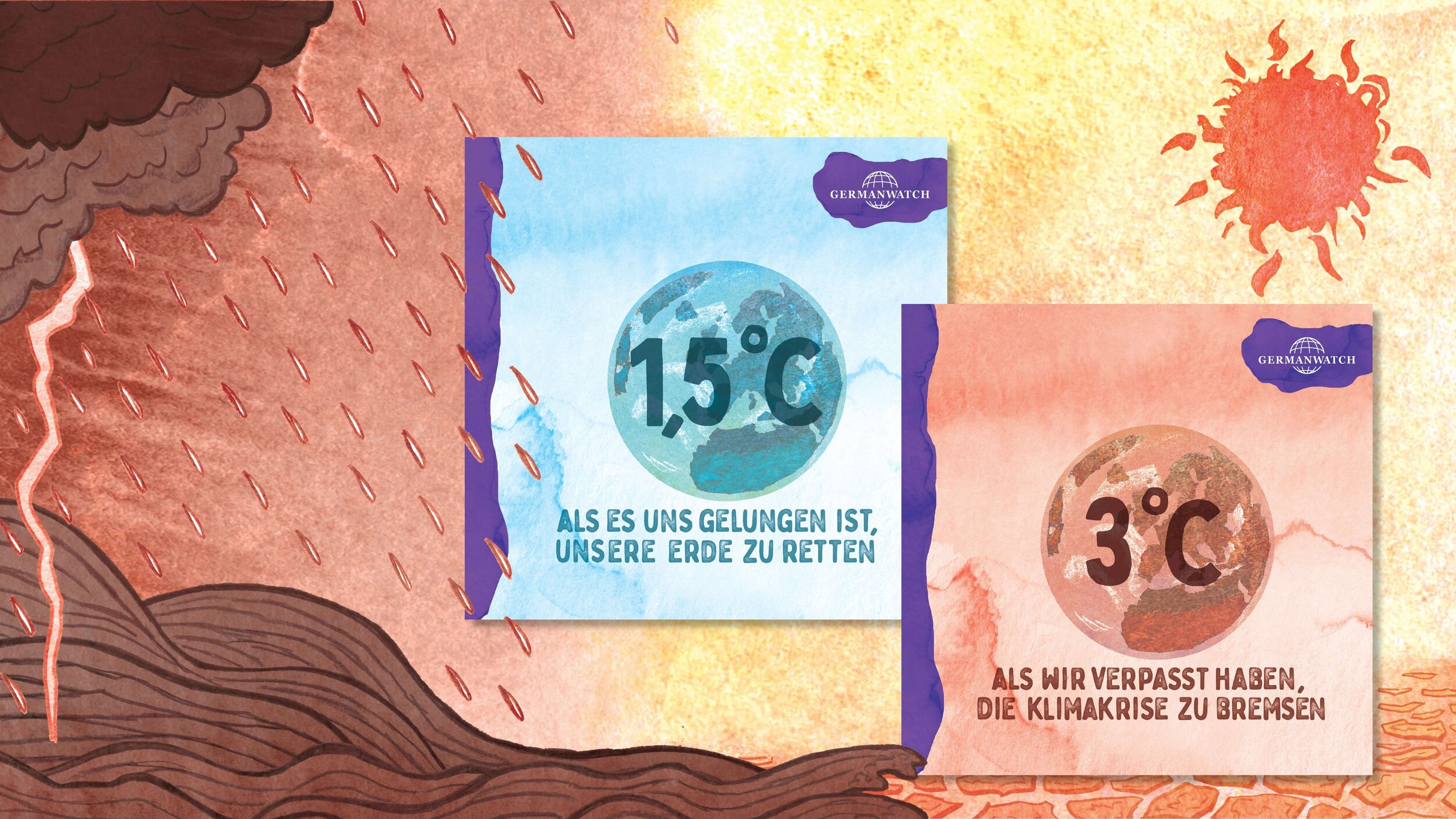
In 2018, a report from the IPCC (International Panel on Climate Change) outlined the impacts that we should expect to see under various warming scenarios. This booklet (68 pages!) takes us on a time-travel adventure into two of those possible futures: a 1,5°C scenario (“in which we managed to save our planet”) and a 3°C scenario (“in which we failed to slow down the climate crisis”). Written by Marie Heitfeld of Germanwatch, it’s intended to engage German speakers of all ages. In addition to the two scenarios, the book includes a middle section that provides tips and recommended actions people can take to reduce their carbon footprint (and to increase their handprint, aka the positive actions that they take).
The book is available to order as a print copy on the Germanwatch website, as well as to download as a PDF as of next week. At this time, it is available only in German.
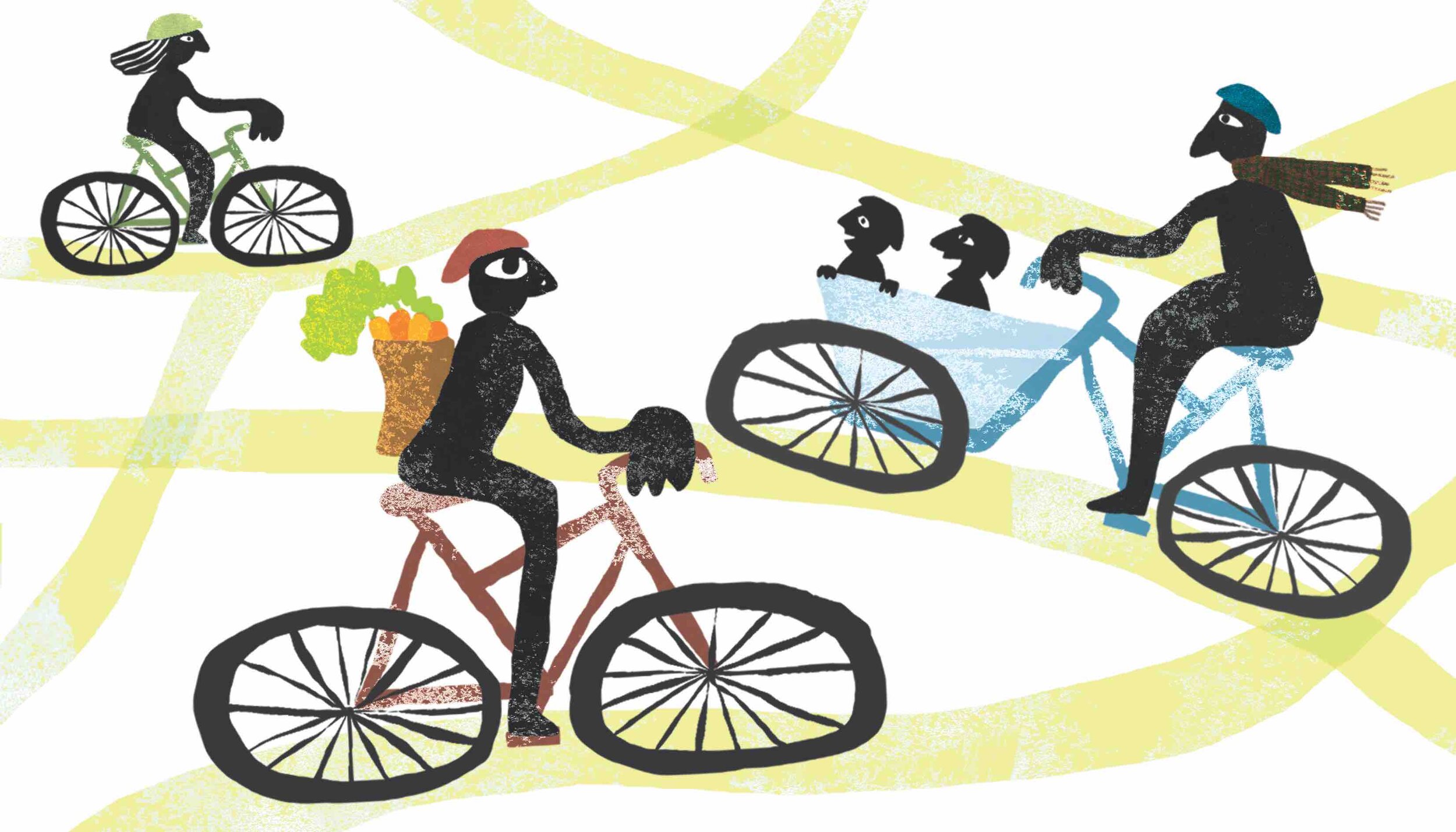
Illustration for a newspaper produced by RENN.west with layout by Katrin Roth, as part of their campaign “Ziele brauchen Taten” (“Goals require action”). You can find and order the full paper here.

Illustration for a newspaper produced by RENN.west with layout by Katrin Roth, as part of their campaign “Ziele brauchen Taten” (“Goals require action”). You can find and order the full paper here.

Illustration for a newspaper produced by RENN.west with layout by Katrin Roth, as part of their campaign “Ziele brauchen Taten” (“Goals require action”). You can find and order the full paper here.

Illustration for a newspaper produced by RENN.west with layout by Katrin Roth, as part of their campaign “Ziele brauchen Taten” (“Goals require action”). You can find and order the full paper here.

Together with LAG 21 and Germanwatch, I created a series of beer coasters that address the 17 sustainable development goals (SDGs). These are lino print images, coloured digitally, which are juxtaposed next to provocative questions that push us to think about the world we inhabit – and how we can begin to achieve the various SDGs. Get a set here! (nur auf Deutsch | only in German).

Collaboration with RENN.west from August 2019 to create a small pamphlet as part of their campaign “Ziele brauchen Taten” (“Goals require action”) to educate people about the UN’s Sustainable Development Goals. I did both layout and illustration. You can find the pamphlet here.
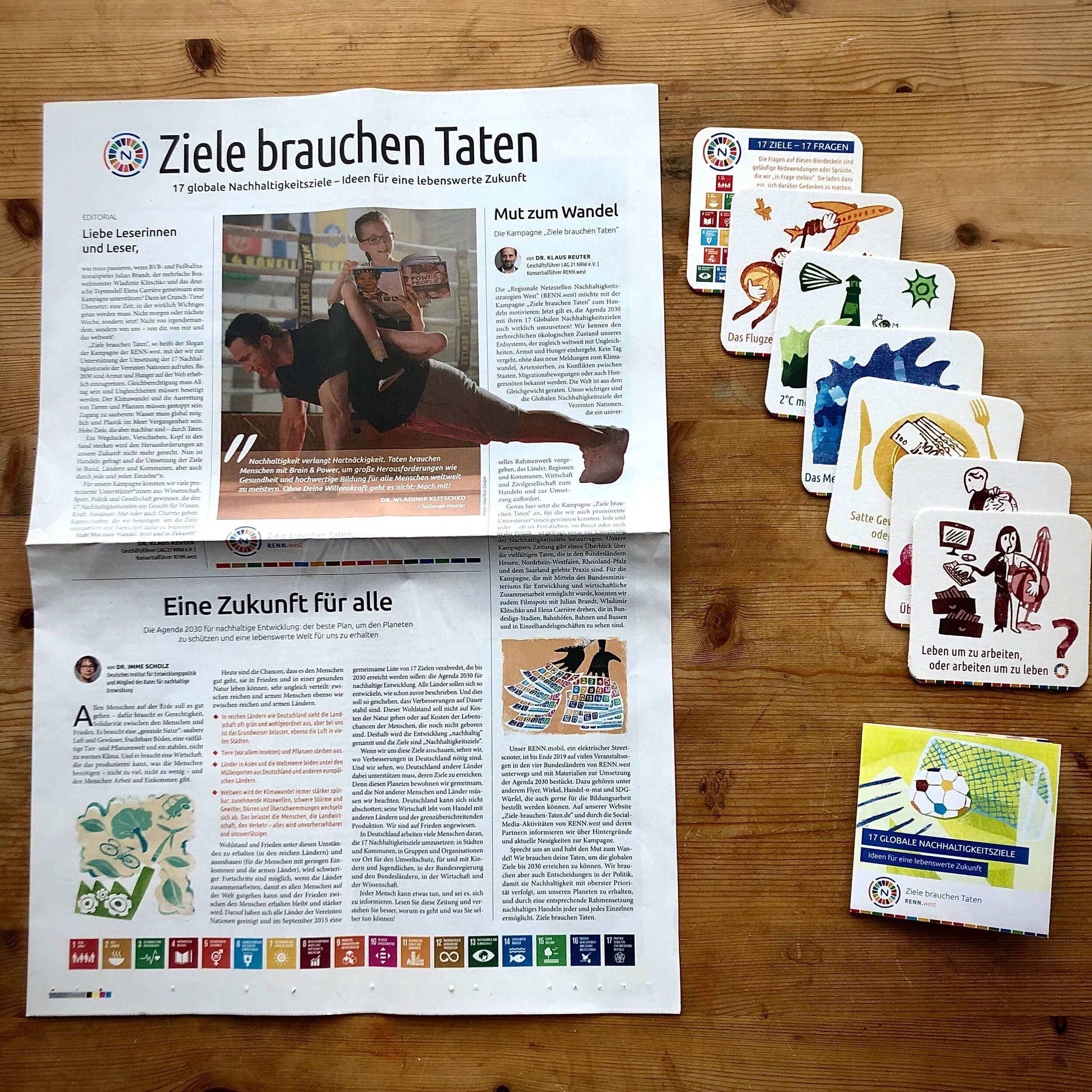
Collaboration with RENN.west from August 2019 to create a newspaper, a small pamphlet, and a series of drinks coasters as part of their campaign “Ziele brauchen Taten” (“Goals require action”) to educate people about the UN’s Sustainable Development Goals. For the newspaper, I produced a collection of illustrations and small icons, while Katrin Roth did layout (you can find the paper here); and for the pamphlet and drinks coasters I did both layout and illustration (you can find the pamphlet here and the coasters here).
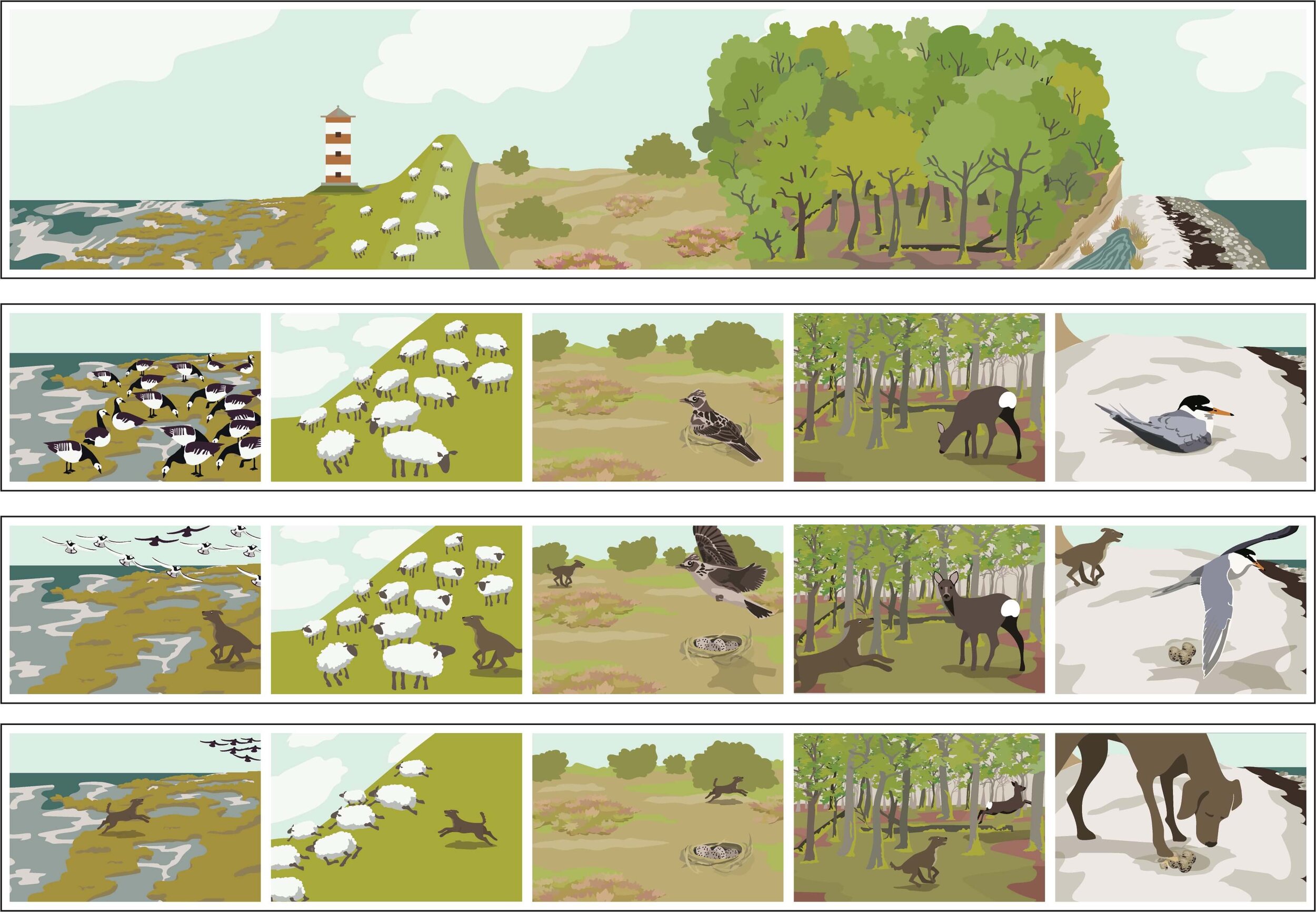
I produced this infographic in collaboration with the Planungsbüro Mordhorst-Bretschneider GmbH, to raise awareness about the impacts of having your dog off-leash out in nature. The top image in a cross-section of Schleswig-Holstein, the state where I live in Germany, with the North Sea on the left and the Baltic Sea on the right. Five ecosystems are summarised, with information about how the presence of off-leash dogs negatively impacts species in each one. This includes stressing migrating birds, scaring ground-nesting fowl away from their nests (which leaves these open to predation), eating or damaging the eggs of ground-nesters, and frightening & stressing deer, sheep and other animals.
You can find the full infographic and pamphlet (in German) here.
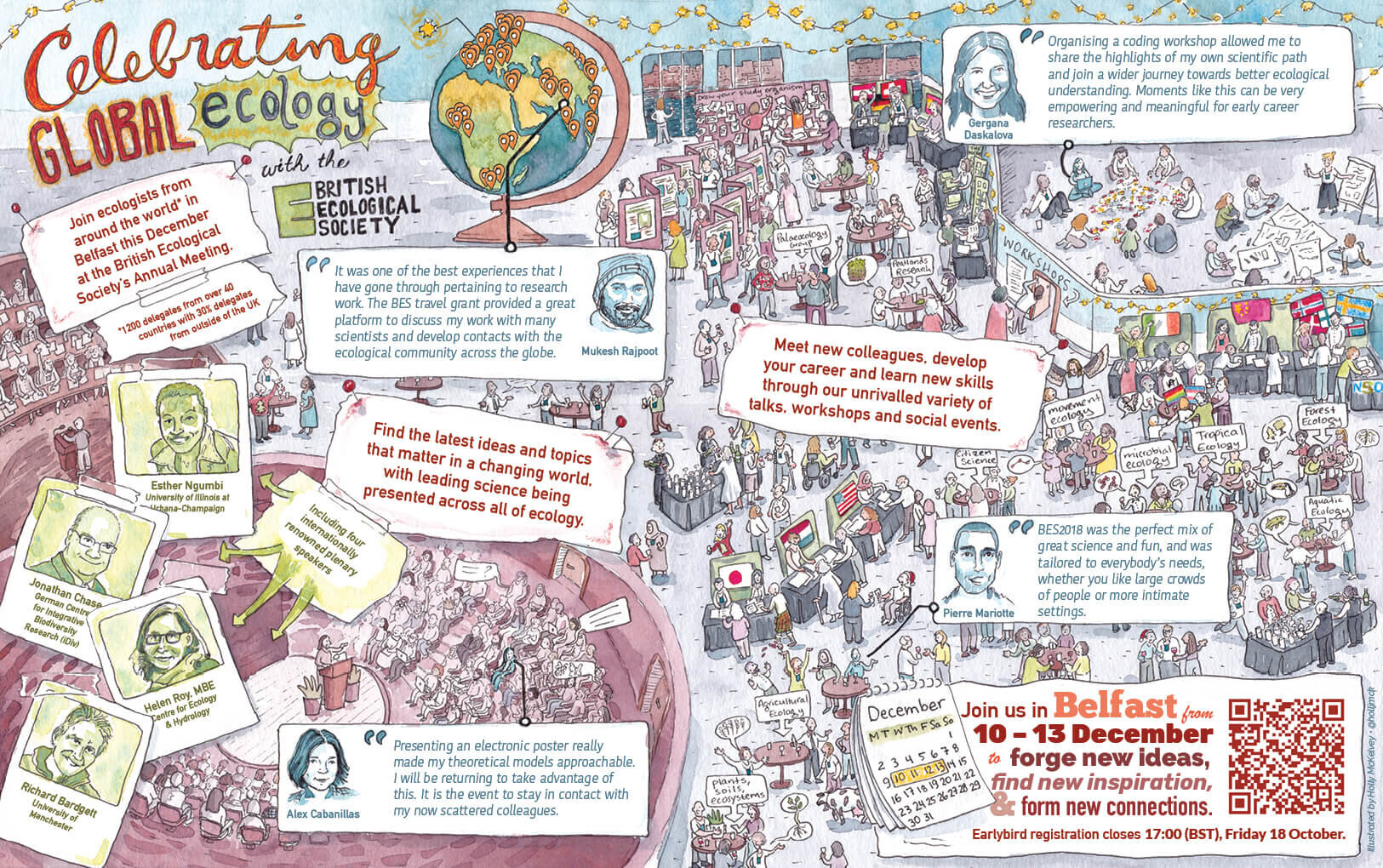
An illustration for the September 2019 issue of The Niche, promoting the December meeting in Belfast. I did this over the course of a few days while sitting at a table in a garden in Castagno di Piteccio, Italy, balancing the time between this and painting murals!

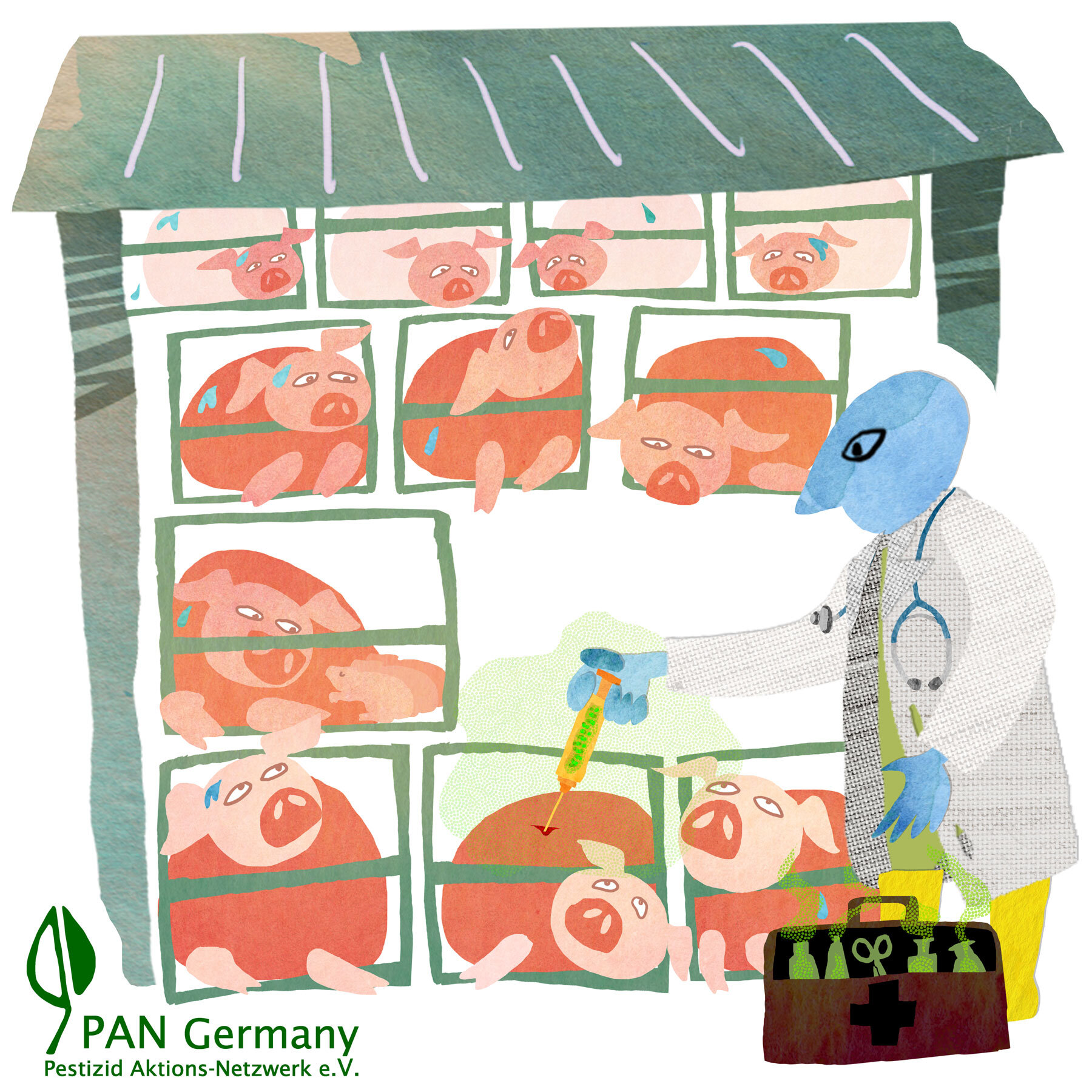
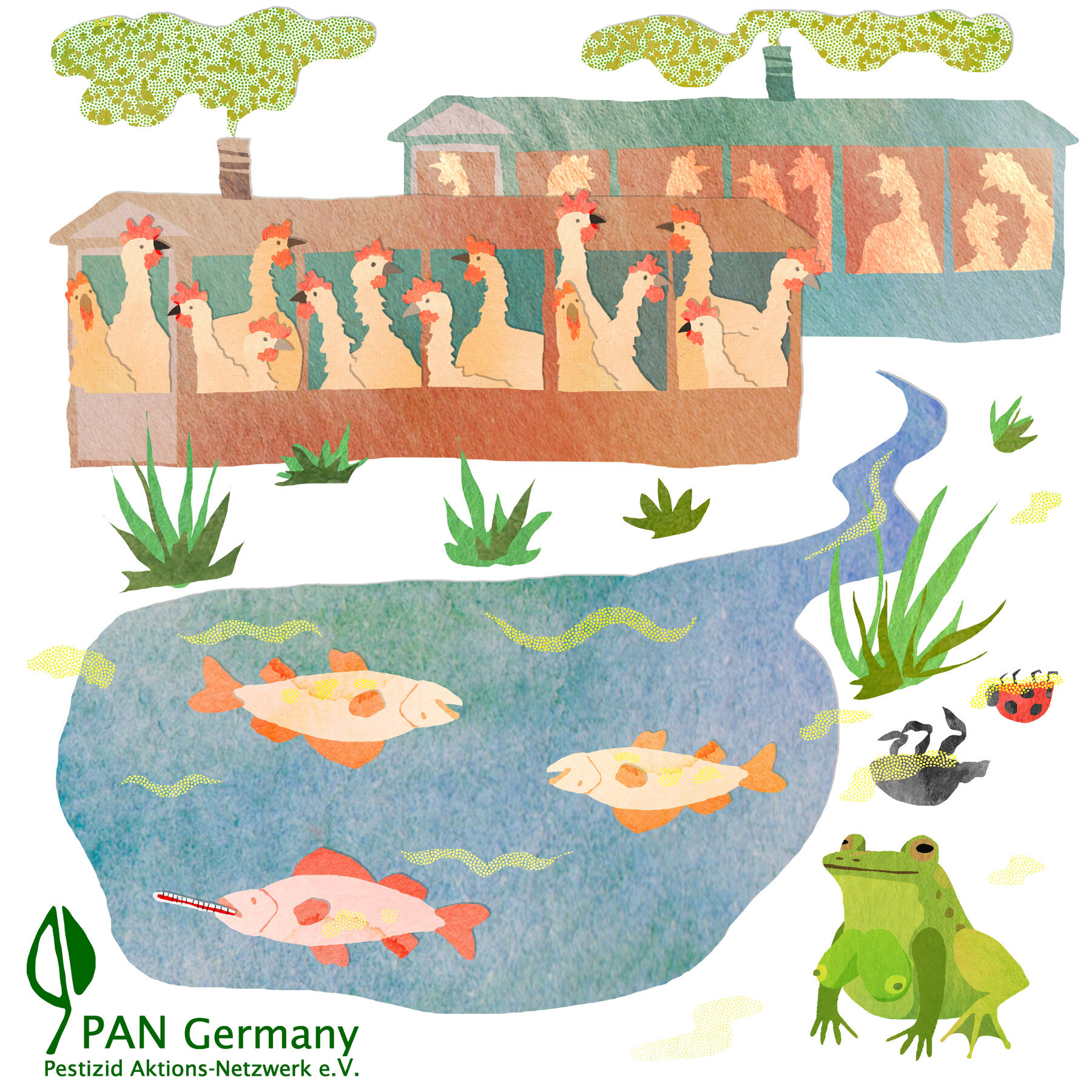
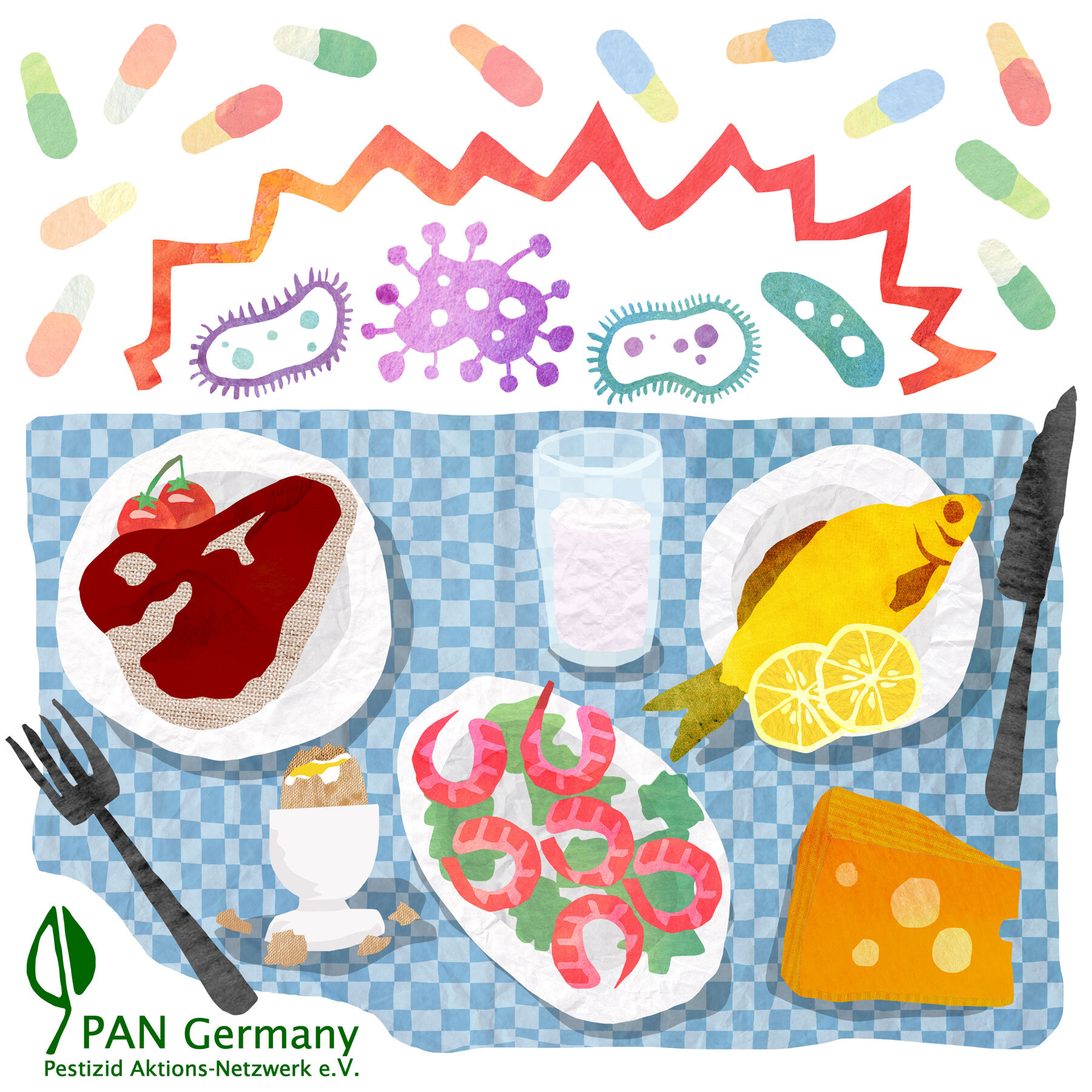
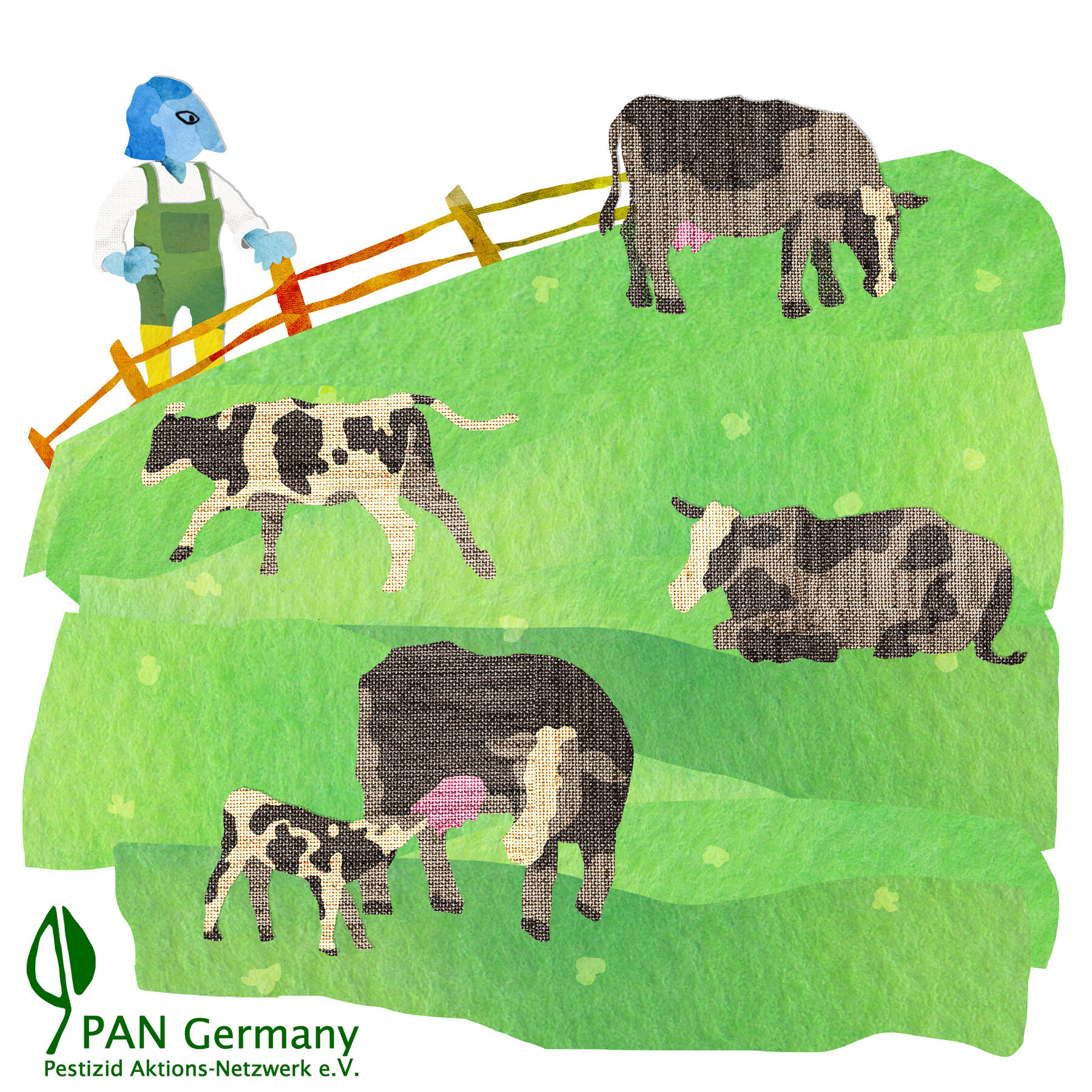
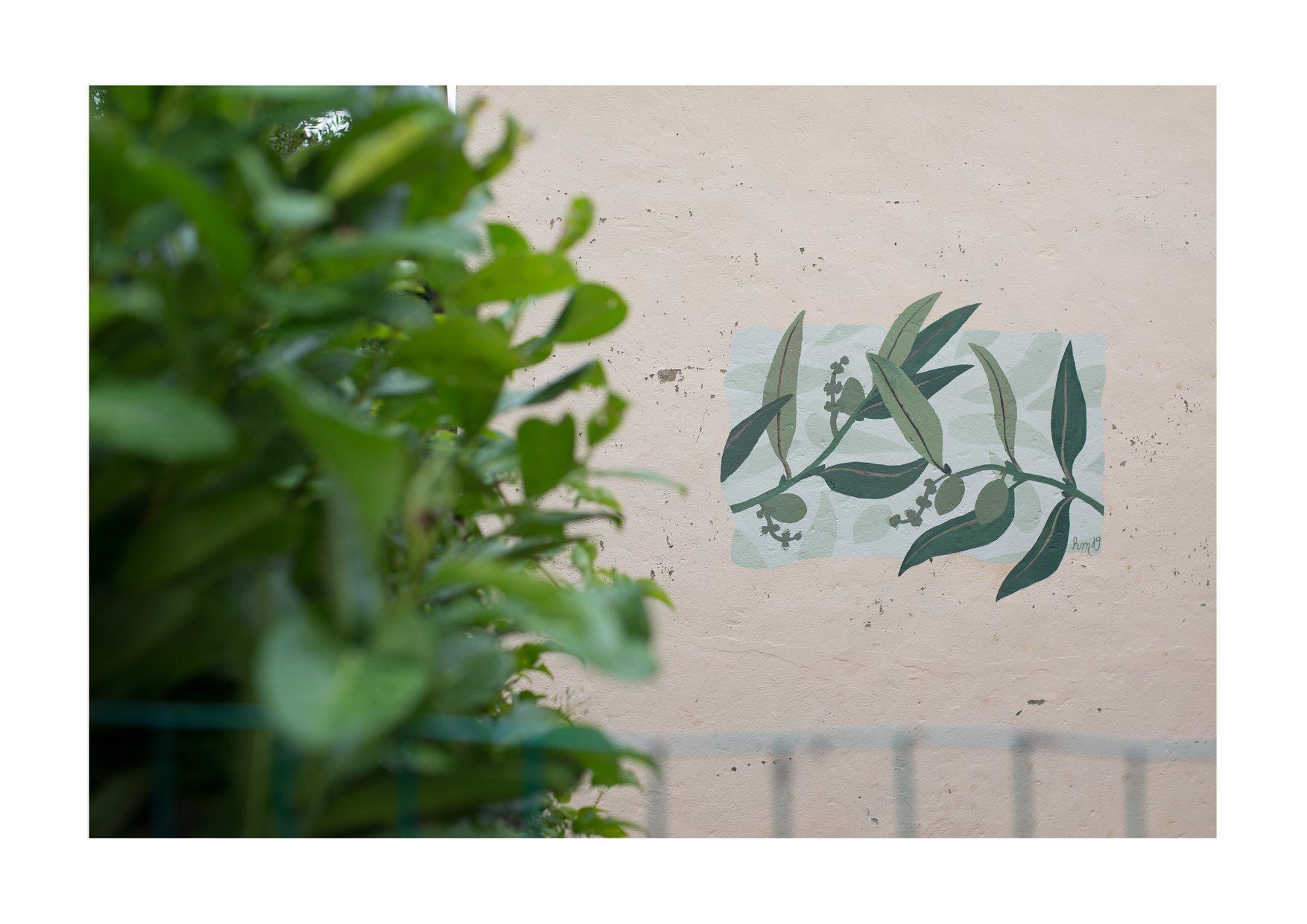
In July 2019, I spent two weeks in Castagno di Piteccio, a small outdoor museum of a town perched in the Tuscan hills above Pistoia, Italy. I stayed in a home on the side of the mountain with two other artists, exploring the town, eating well, meeting the wonderful people who live there, and creating art. One family graciously offered me the side of their building to paint, where I created a three-panelled “comic layout” mural with scenes of Castagno. This makes up a further chapter of my “Portraits of Place” series, exploring the identity of place through its ecology.
Photo by the amazing Rachele Salvioli.

In July 2019, I spent two weeks in Castagno di Piteccio, a small outdoor museum of a town perched in the Tuscan hills above Pistoia, Italy. I stayed in a home on the side of the mountain with two other artists, exploring the town, eating well, meeting the wonderful people who live there, and creating art. One family graciously offered me the side of their building to paint, where I created a three-panelled “comic layout” mural with scenes of Castagno. This makes up a further chapter of my “Portraits of Place” series, exploring the identity of place through its ecology.
Photo by the amazing Rachele Salvioli.

In July 2019, I spent two weeks in Castagno di Piteccio, a small outdoor museum of a town perched in the Tuscan hills above Pistoia, Italy. I stayed in a home on the side of the mountain with two other artists, exploring the town, eating well, meeting the wonderful people who live there, and creating art. One family graciously offered me the side of their building to paint, where I created a three-panelled “comic layout” mural with scenes of Castagno. This makes up a further chapter of my “Portraits of Place” series, exploring the identity of place through its ecology.

Another infographic I got to do! This one is for Functional Ecology, a journal from the British Ecological Society, and it is for a special feature on how coral reef functions (including the ecosystem services we derive from them) will continue to evolve as we see further climate and technological change. It includes seven articles, as well as an editorial introducing and summarizing the special feature. You can find the colour-coded articles at the lower left, and see which topics they correspond to in the different parts of the infographic!
.
Find the articles here. Happy reading!

An infographic I did for People and Nature on the economic benefits of managing invasive species. How do we measure how much money we’ve saved by controlling invasive species? Authors Nick Hanley and Michaela Roberts walk us through various methods employed to estimate costs – and costs saved – in their great new article. Find the article here, and the infographic here. Happy reading!
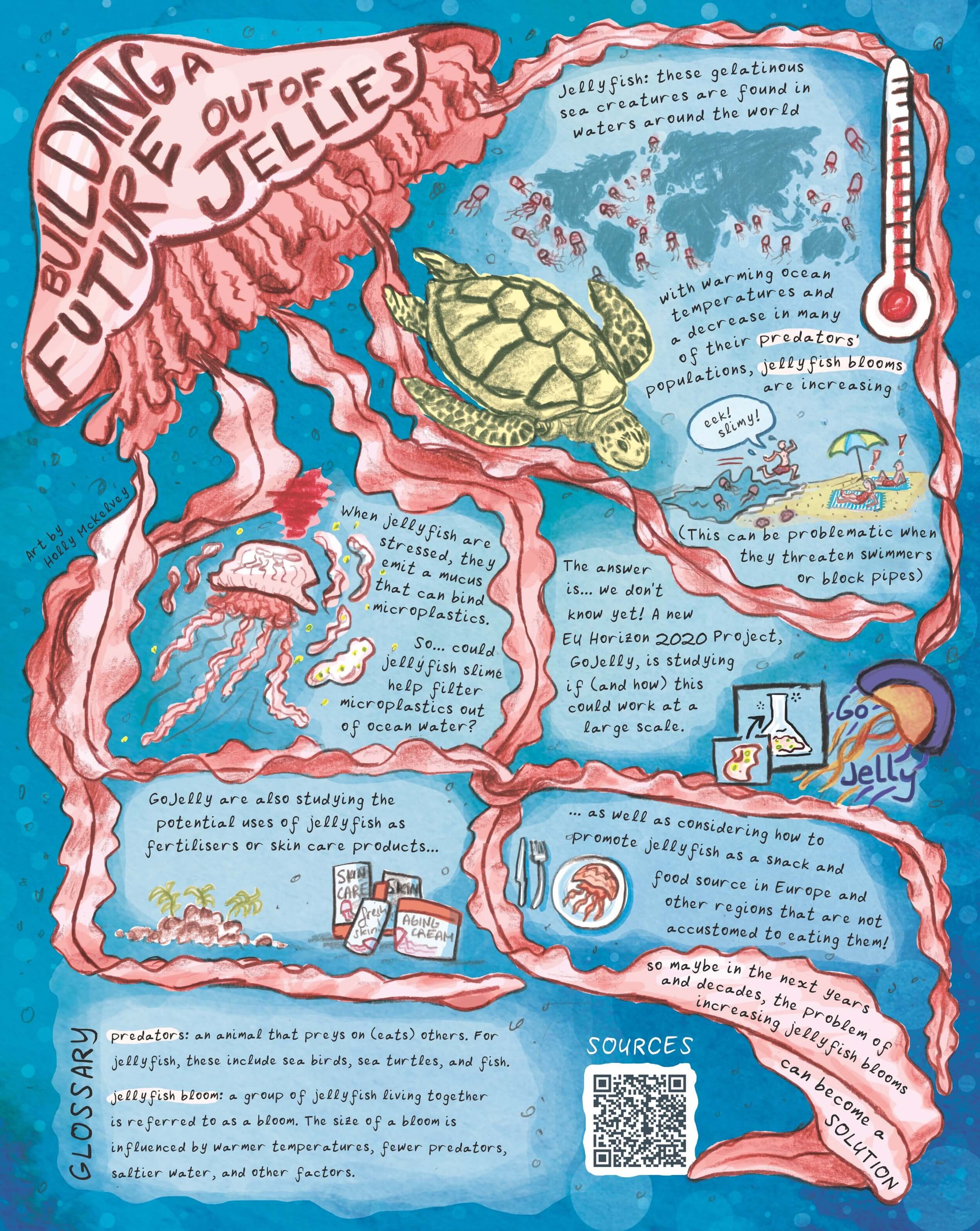
It’s June, which means another comic for The Niche, a quarterly publication from the British Ecological Society! This time I was feeling a marine vibe, so wrote about marine jellyfish and the challenges (and opportunities!) they offer. Jellyfish blooms are increasing in size with factors like warmer weather, which raises the question of whether we can use these blooms (and control them in the process). Currently, an EU-funded research project, GoJelly, is looking into various possibilities: can jellyfish be used to filter microplastics out of water? Can they be used at a wider scale as fertilizer? What about in skin products? And to what extent can we start serving them up on dinner plates here in Europe? These are all exciting possibilities, and an interesting way of looking at challenges as opportunities in a changing ecological landscape.
.
This image was originally published in The Niche, British Ecological Society. 50(2), June 2019: p 9.

Here is an illustration I got to do for Stonecrop Review to accompany a beautiful piece on the mudlarks along the Thames – a community of people who (permits in hand) sift through the mud at the river’s banks in search of the treasures it might yield up. The piece was written by Mackenzie Weinger.

Here is an illustration I got to do for Stonecrop Review to accompany a beautiful piece about childhood memory of place and sense of home, HaOdem 6 by Anna Moritz (find her on Instagram, or see her work on Mental Papercuts).

Another illustration I did for Stonecrop Review’s first issue! This is one of two illustrations (pencil/watercolour/digital) done for Kate Finegan’s piece “Your Own Two Hands”. It’s the opening story in our magazine, capturing the intersection of city and nature through a series of vignettes and portraits of raccoons. The story is rich in details and imagery, and I loved trying to capture as many as possible in this drawing!
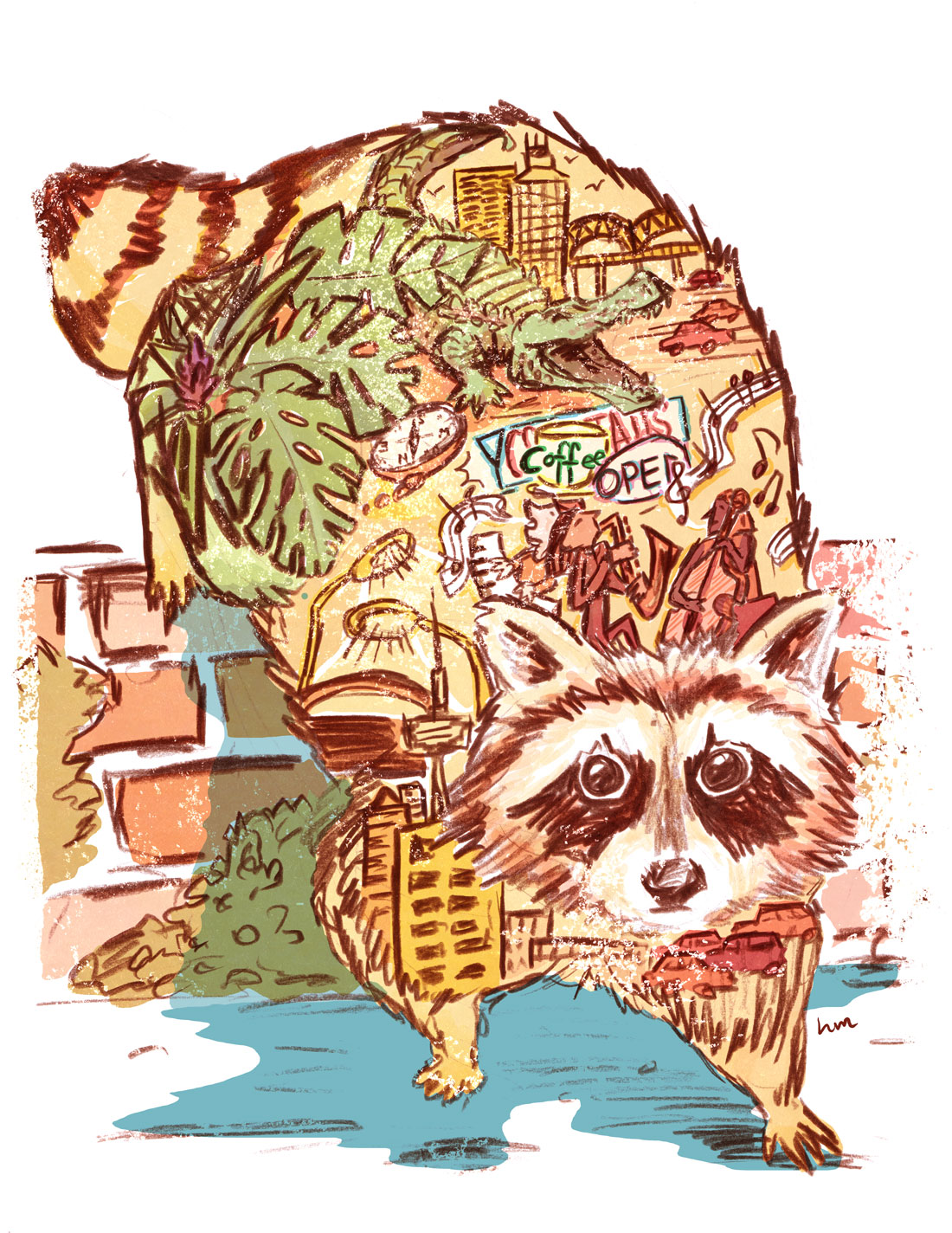
One of the illustrations I did for Stonecrop Review’s first issue! This is one of two illustrations (pencil/watercolour/digital) done for Kate Finegan’s piece “Your Own Two Hands”. It’s the opening story in our magazine, capturing the intersection of city and nature through a series of vignettes and portraits of raccoons. The story is rich in details and imagery, and I loved trying to capture as many as possible in this drawing!
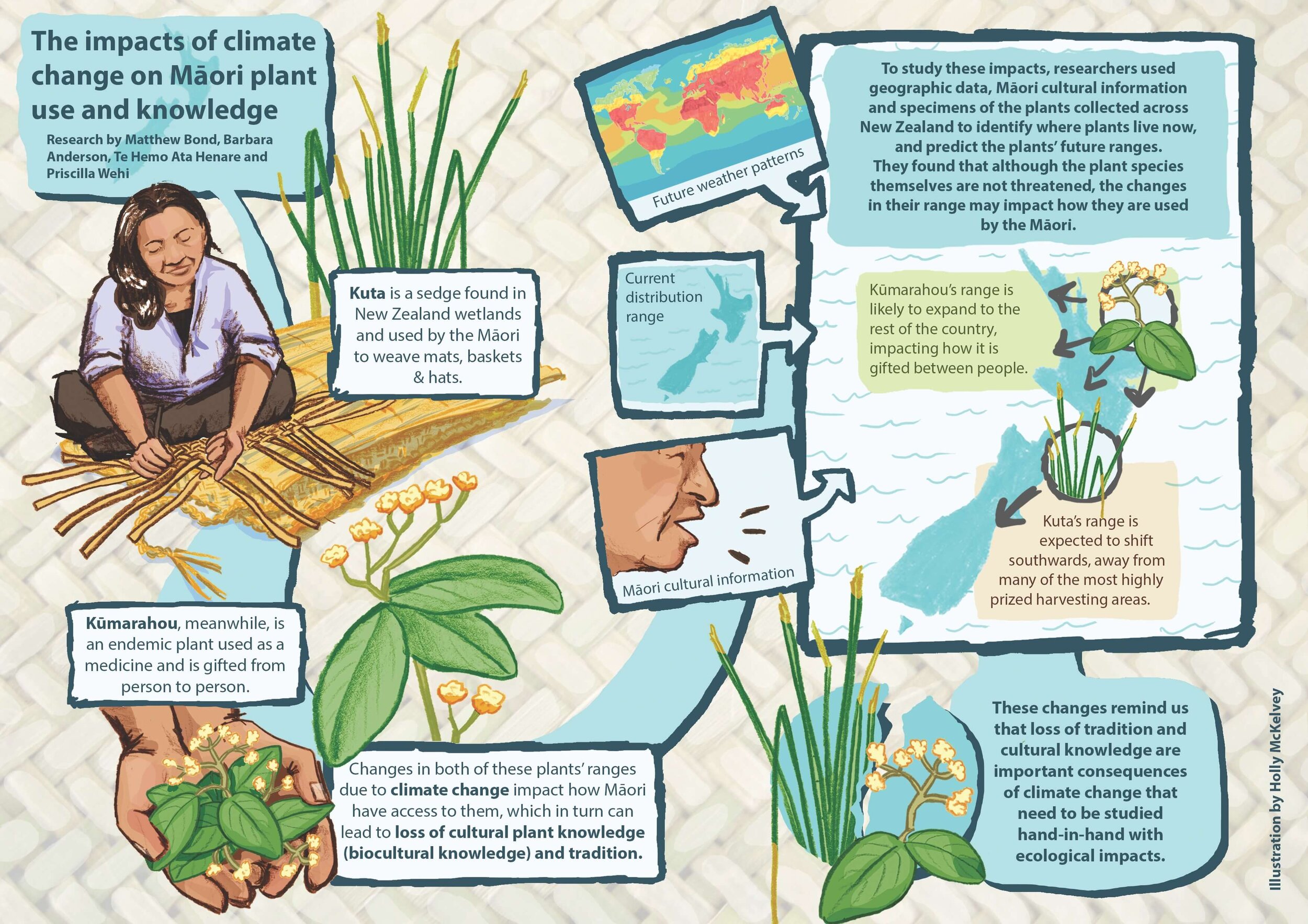
This infographic appeared on the People and Nature blog, Relational Thinking, to accompany a plain-language summary of an article published in People and Nature, British Ecological Society. 1(1), March 2019: pp87-102 (read the plain-language summary here).
The article, Effects of climatically shifting species distributions on biocultural relationships (by Matthew Bond, Barbara Anderson, Te Hemo Ata Henare, and Priscilla Wehi) explores how climate change impacts cultural knowledge and human-nature relationships. Specifically, the research examined two plant species used for weaving and medicine by the indigenous Māori people of New Zealand. It looked at how the plants’ ranges will likely shift as a result of climate change, and compared this to where the plants are currently harvested. Although the plants themselves are not threatened by climate change, they will move away from prized harvesting areas! This could have significant impacts on access to the plants, which could in turn impact use of the plants and ultimately lead to loss of traditional knowledge. This article reminds us how important it is to consider impacts like this when studying climate change!
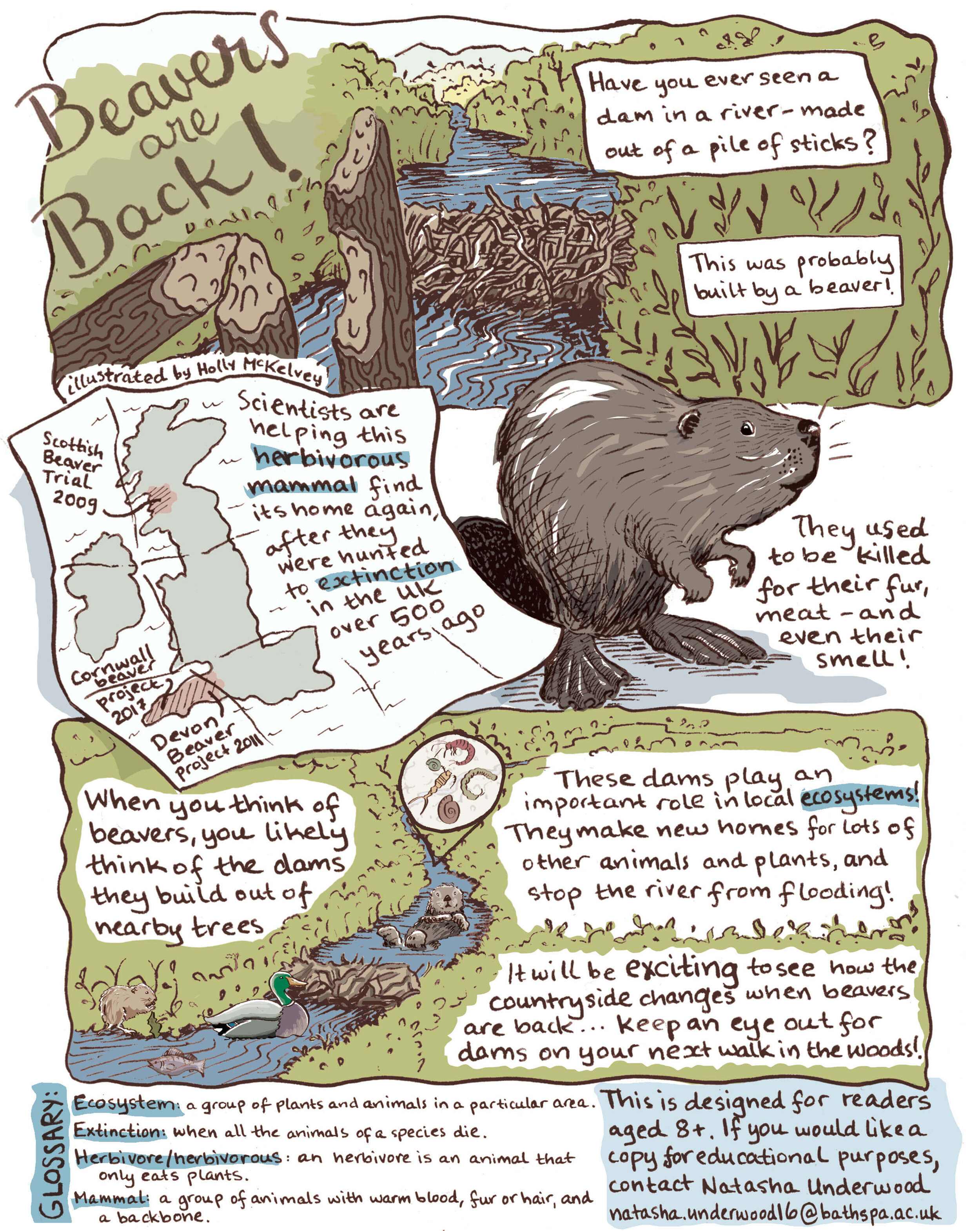
Beavers are back! This comic, all about beaver reintroduction to the UK, is out now in The Niche, the @britishecolsoc’s amazing quarterly magazine. It’s worth becoming a member just to be able to read this magazine, it’s so chock full of wonderful articles on exciting ecology research going on in the world. And as always, I’m so honored to get to be a part of it!
This comic was made in collaboration with @natasha.underwood, to serve as supplementary reading for outreach and education about beaver reintroduction. It’s a reminder of the important role that beavers play in ecosystems. Not only do they create habitat for other animals, their dams can benefit human infrastructure, too, by regulating and diminishing downstream flooding.
.
This comic was originally published in The Niche, British Ecological Society. 50(1), March 2019: p9.
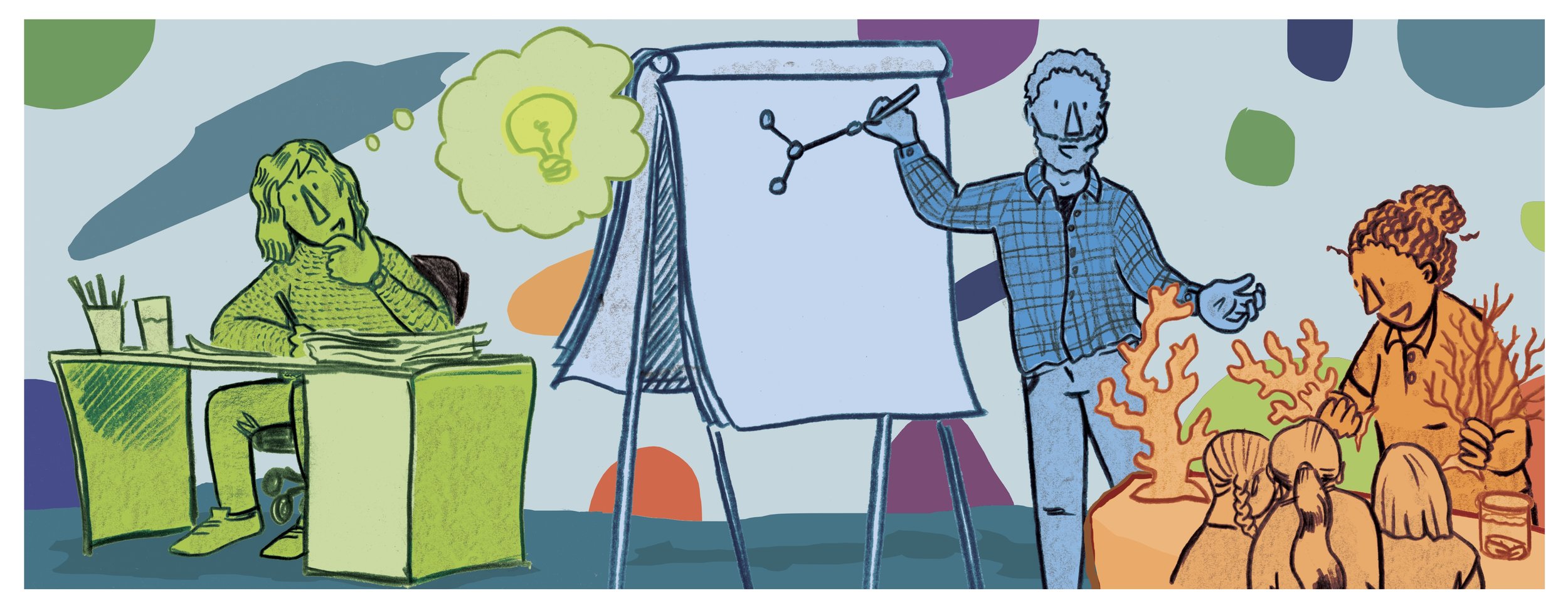
Illustrations for the Kiel University Graduate Center’s brochures. These advertise various course offerings that help graduate students learn better time management, as well as improve their study skills or learn to more effectively communicate and present their research. As always, I am 100% there for anything involving science communication!

Illustrations for the Kiel University Graduate Center’s brochures. These advertise various course offerings that help graduate students learn better time management, as well as improve their study skills or learn to more effectively communicate and present their research. As always, I am 100% there for anything involving science communication!
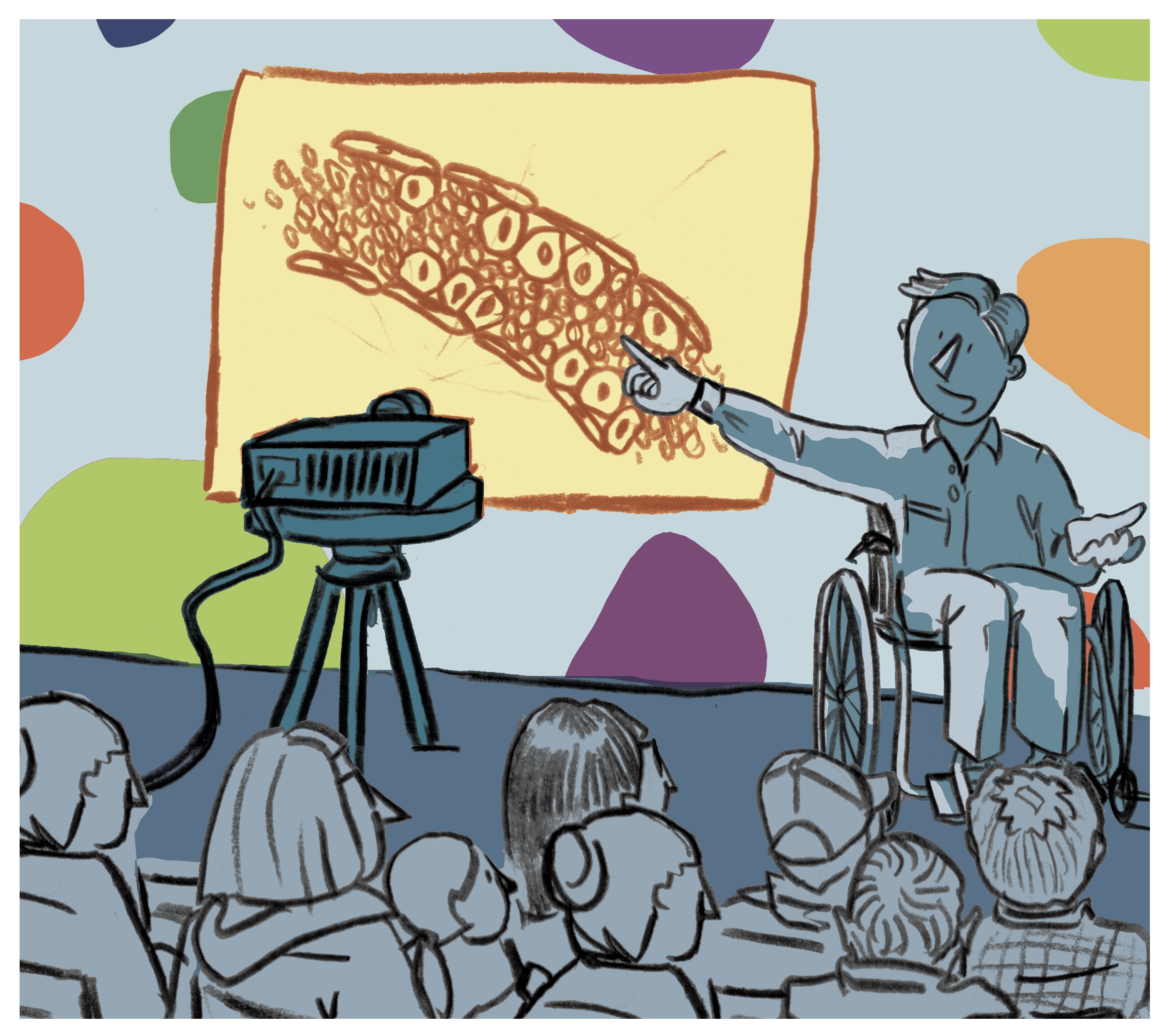
Illustrations for the Kiel University Graduate Center’s brochures. These advertise various course offerings that help graduate students learn better time management, as well as improve their study skills or learn to more effectively communicate and present their research. As always, I am 100% there for anything involving science communication!

Last July, I spent a week in Palermo, Italy, exploring its green corners and creating a visual portrait of the city’s plants. The week itself was magnificent, and getting to put together this image afterwards felt like revisiting the city’s corners all over again. It felt at once hugely familiar and entirely new. The vegetation in this mediterranean environment is so similar to that in California where I grew up, a reminder of the extent to which we’ve scattered and transported our favourite plants across the globe. And of course, hearing Italian – even if I can’t understand it as well as I used to – reminds me of living in Italy as a teenager, and brings back those familiar emotions of new horizons and overcoming shyness and stumbling forward in new and unfamiliar environments.
This is a continuation of my “Portraits of Place” series, and my decision to use tiles in this piece stemmed from the ubiquitousness of maiolica tiles in Palermo. The tiles both shape and reflect the city, and the images on them provide us with glimpses into the plants of Palermo during the last centuries.
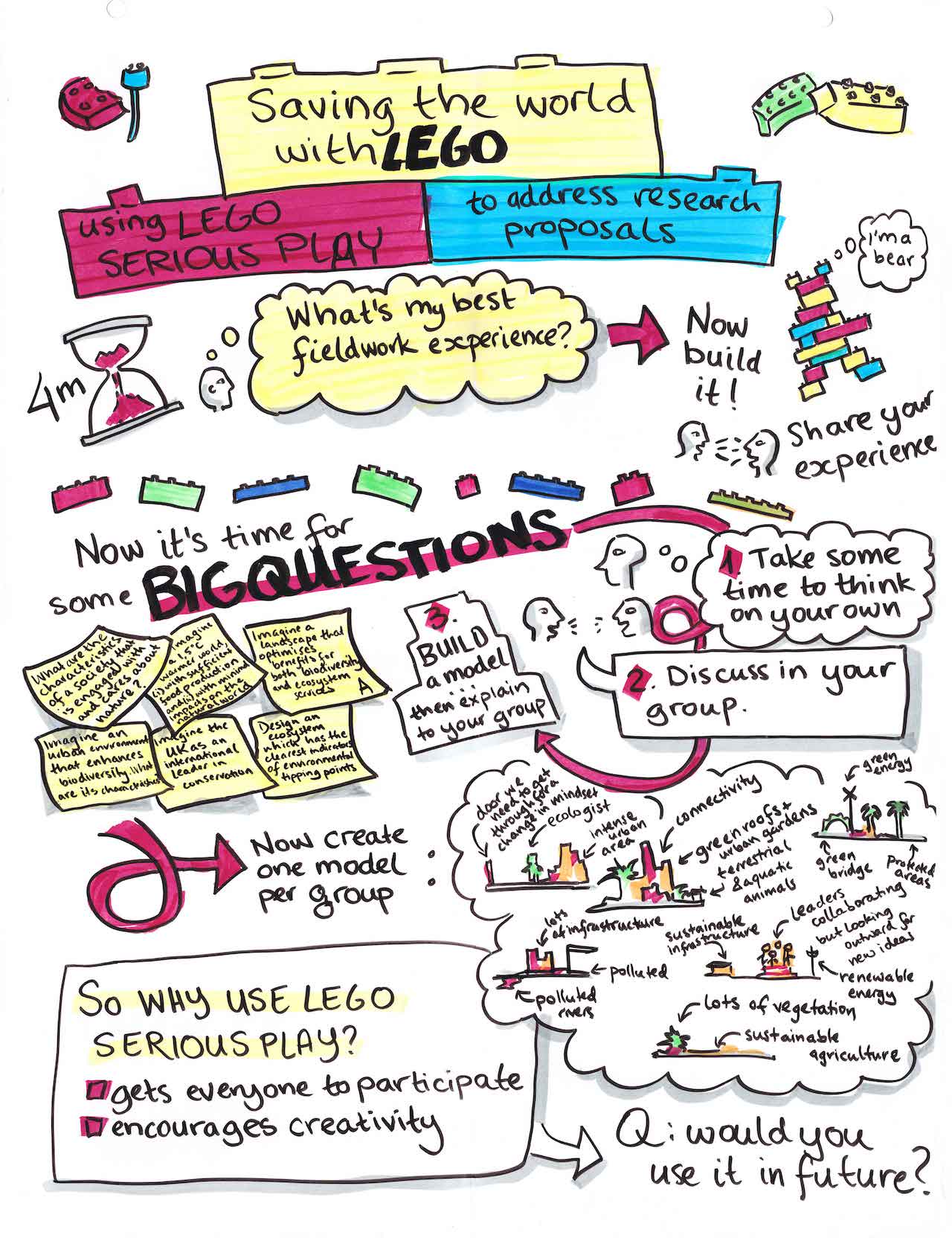
This is an example of some of the graphic recording I did recently at the British Ecological Society’s annual meeting in Birmingham in December 2018. I got to attend multiple sessions and workshops, including this amazing workshop about LEGO serious play (basically getting adults to take off their grown up hats, sit down on the floor in a circle, and get creative! The idea is that it not only sparks creativity, but also, when structured right, creates an inclusive space where everyone has an opportunity to speak up).
Check out the rest of the graphic recording from the conference here!

Another piece for the British Ecological Society’s quarterly bulletin! This one deals with topics within conservation, and the concept of “novel ecosystems”. Are these human-modified ecosystems a valuable resource to be studied and observed? Are they symbols that we’ve allowed old ecosystems to become too modified? Should we attempt to restore old ecosystems? These are big questions that ecologists and conservationists deal with every day, and I think there’s no completely right answer. That said, I am fascinated by the idea of studying modified ecosystems, and observing how nature shapes itself around ongoing human impact.

I recently got asked to do a graphic for a lecture series in Nordrhein-Westfalen on regional sustainability; you can find the graphic in its new home, as well as info about the talks here at the Landesarbeitsgemeinschaft Agenda 21 NRW website. The graphic was a lot of fun to make: it needed to contain agriculture, technology, innovation, demographic change, digitalization, ecology, and sustainable technology and development. The obvious solution? Network nodes, where each node communicated a different topic!
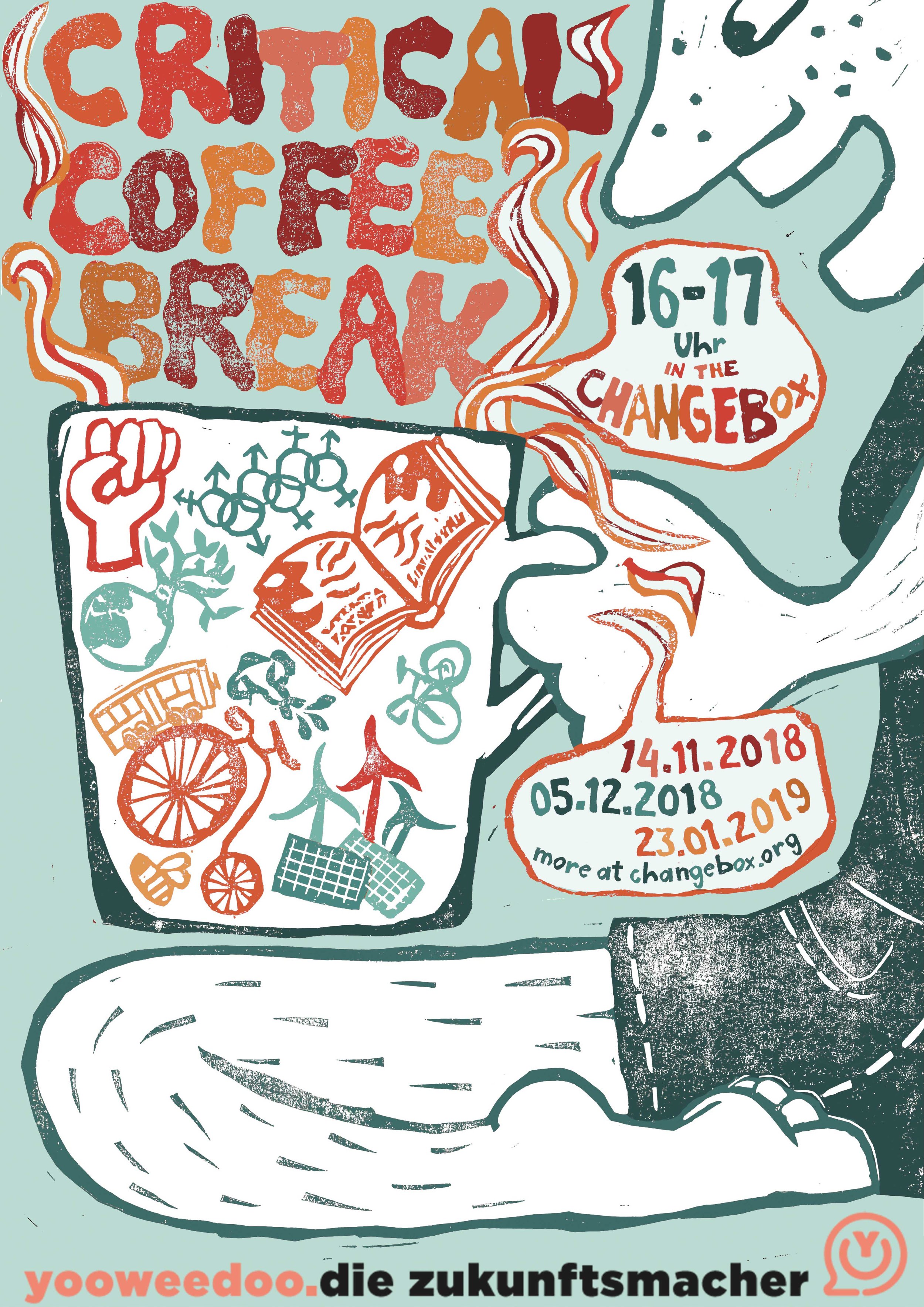
A poster I did to promote a periodic afternoon meeting to discuss all sorts of current topics: from feminism to sustainability to queer issues to social engagement. For those of you in Kiel looking for an interesting space to sit down and talk with other engaged students, check it out!
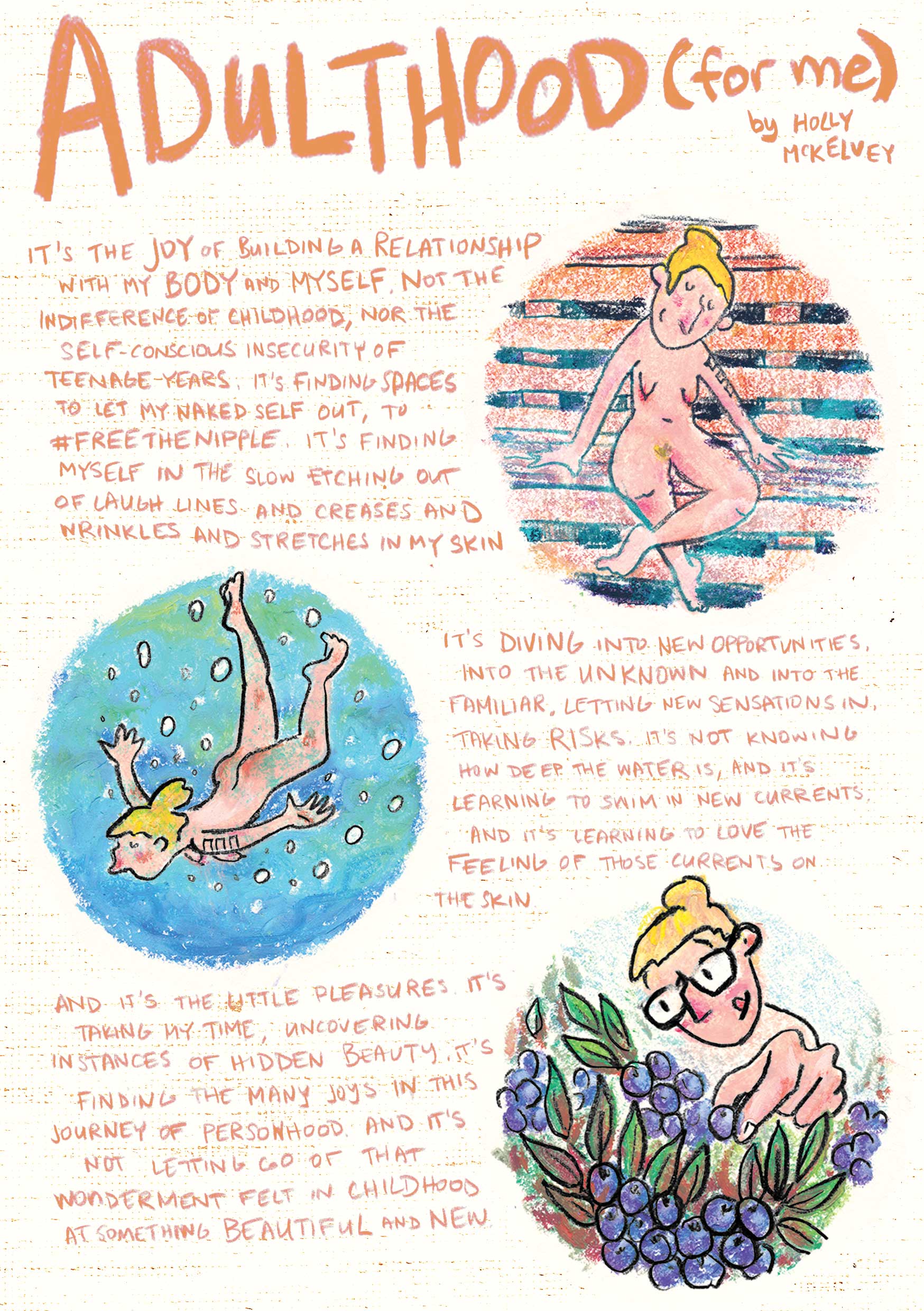
My contribution to the zine “Grow n’ Pains”, which is compiled by It’s Kinda Okay. I loved thinking about what adulthood means to me, and allowing my recent time in Sweden to influence the visuals for this piece.

This is a piece I did for Split Rock Review’s Autumn issue, exploring humans in nature - expectations, unexpected weather, and finding beauty inside of that! Very much based on a real camping trip on the SHT, which ended up being fabulous despite – and perhaps even because of – all the rain.
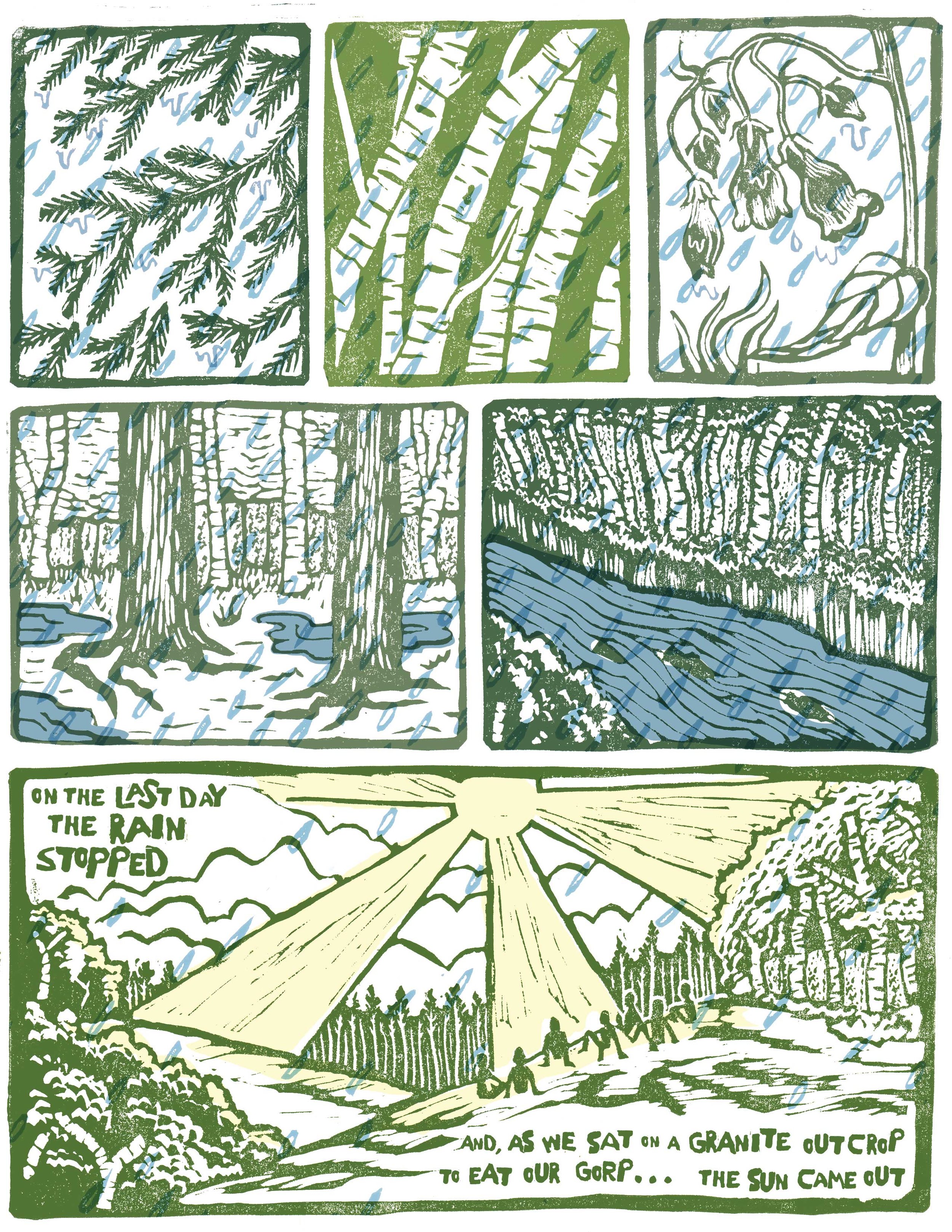
This is a piece I did for Split Rock Review’s Autumn issue, exploring humans in nature - expectations, unexpected weather, and finding beauty inside of that! Very much based on a real camping trip on the SHT, which ended up being fabulous despite – and perhaps even because of – all the rain.
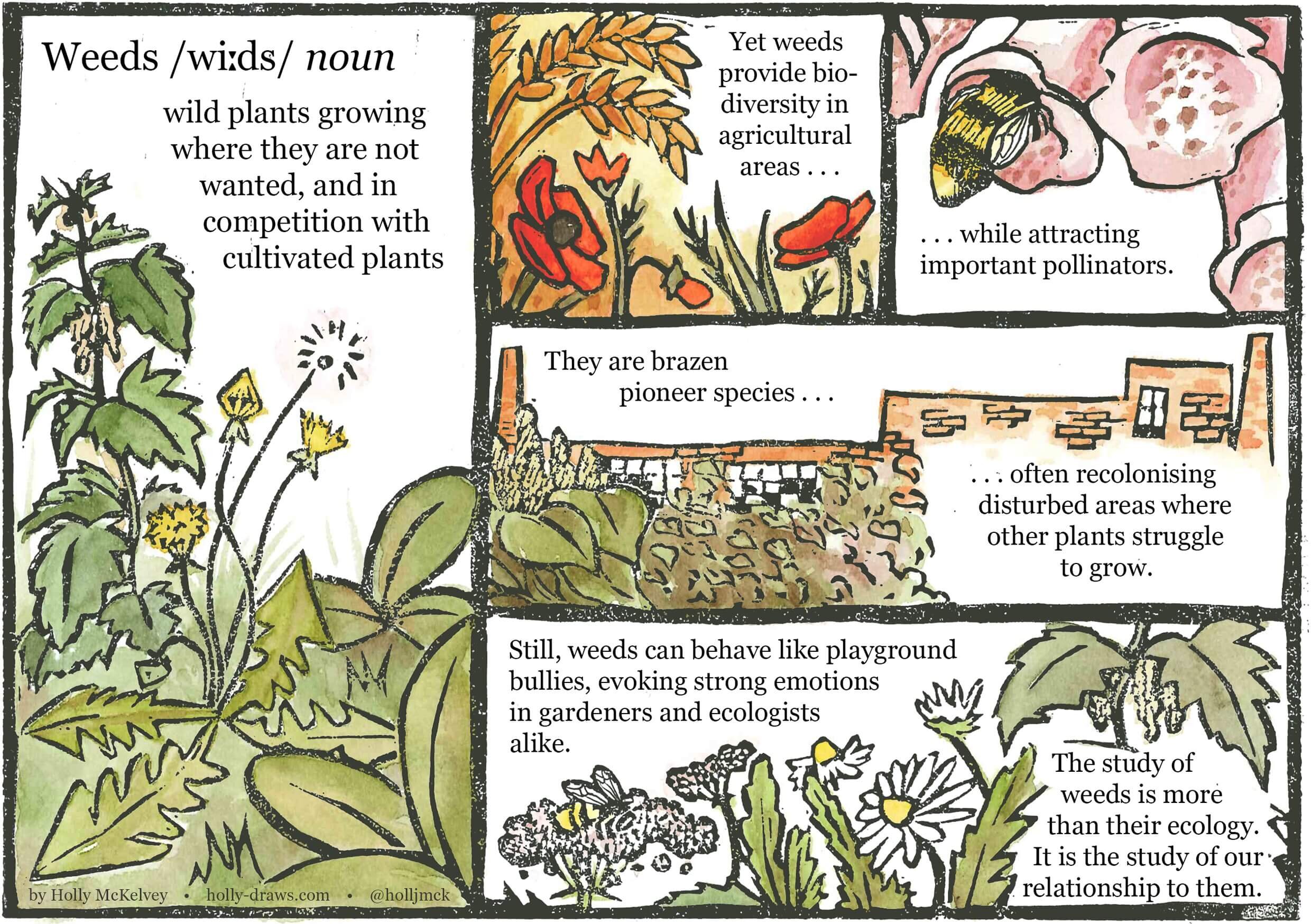
An ode to weeds and our complicated human relationship to them, for the British Ecological Society’s September Bulletin.
Recommended reading to accompany this comic: Weeds: How Vagabond Plants Gatecrashed Civilisation and Changed the Way We Think About Nature by Richard Mabey.
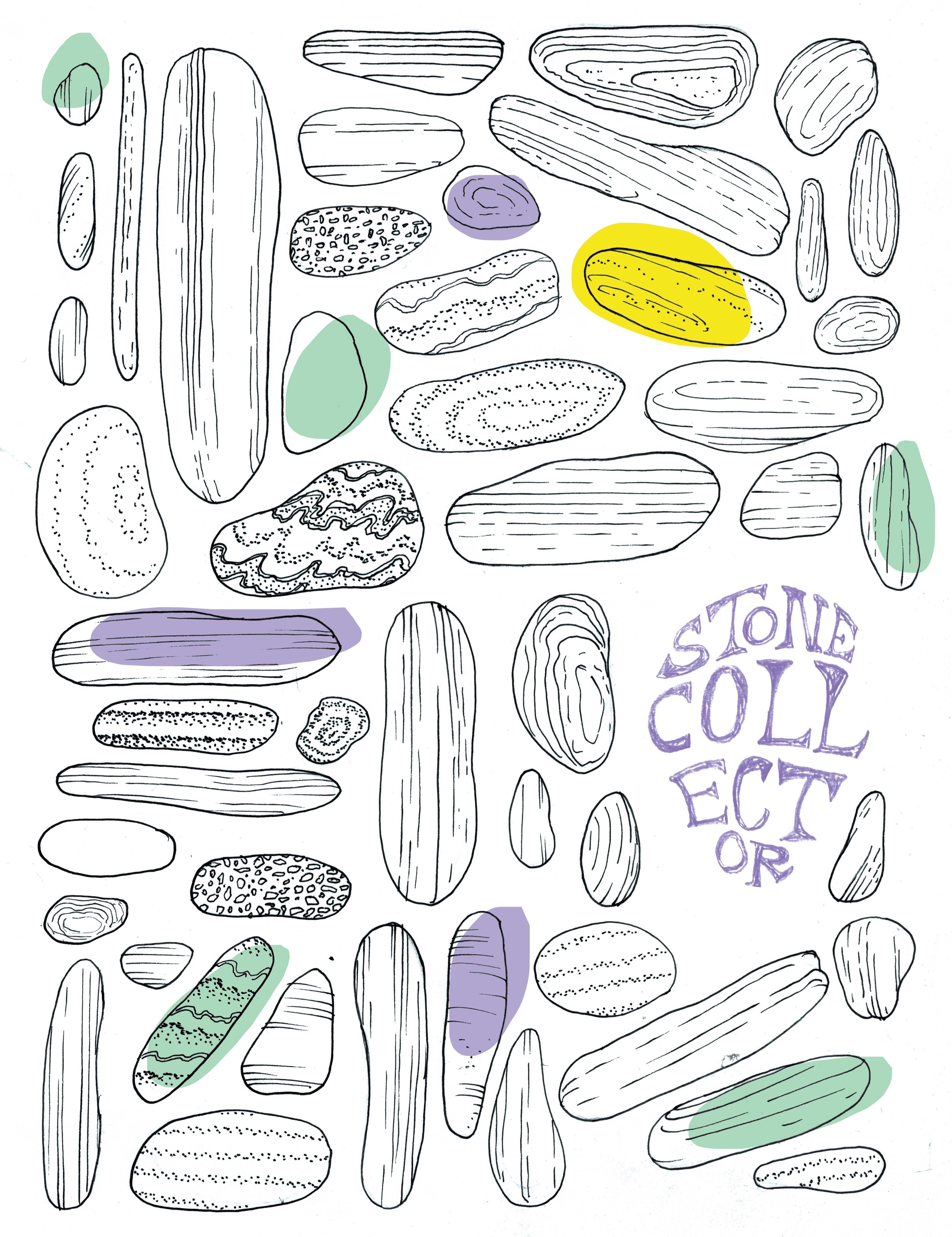
What do you get when you lock up 13 illustrators in a room for a long weekend with the word prompt “Wunderkammer” (cabinet of curiosities), a colour palette, and the aim of putting together an anthology? Here’s my contribution from the weekend, inspired by my own collection of beautiful slender rocks from Lake Baikal.
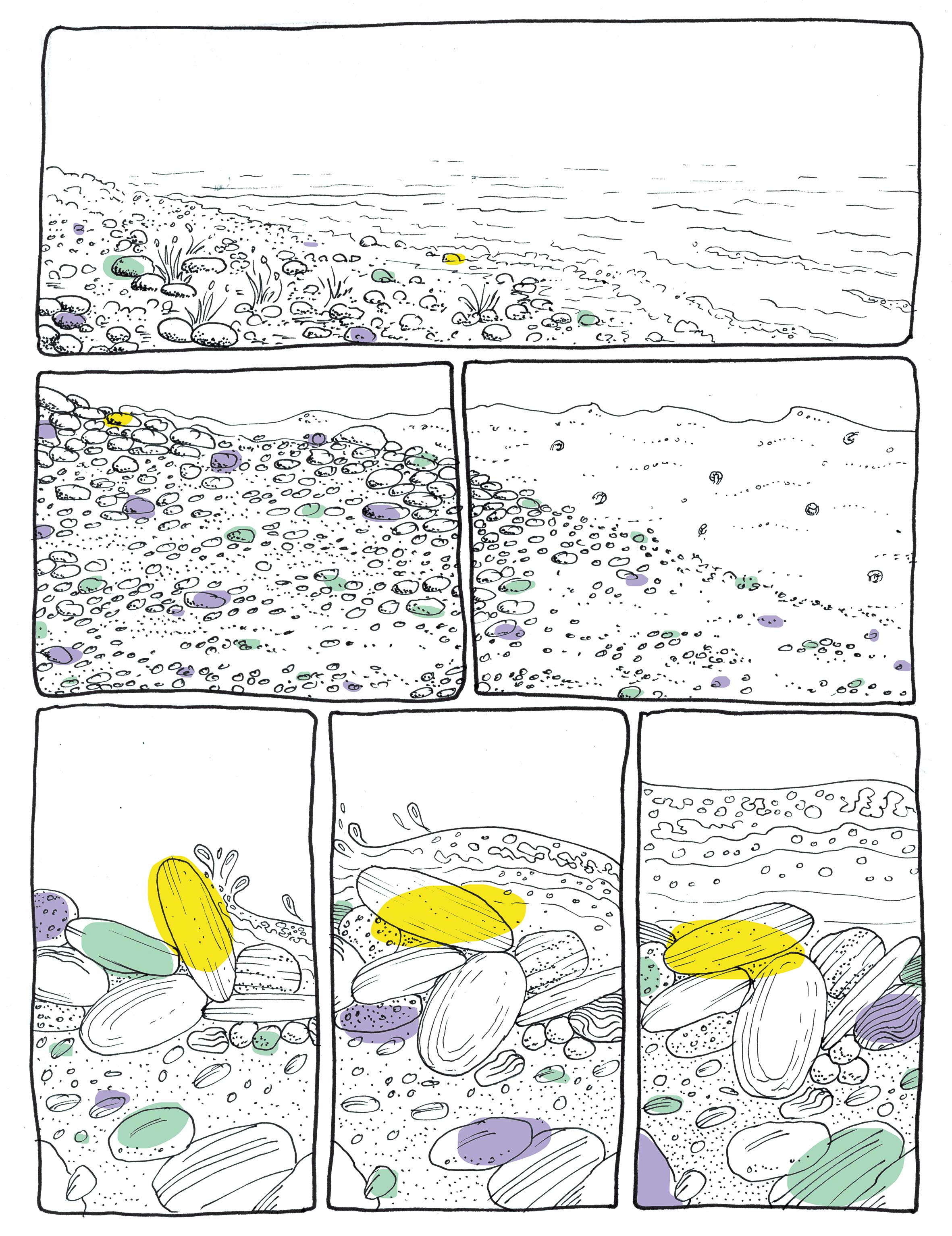
What do you get when you lock up 13 illustrators in a room for a long weekend with the word prompt “Wunderkammer” (cabinet of curiosities), a colour palette, and the aim of putting together an anthology? Here’s my contribution from the weekend, inspired by my own collection of beautiful slender rocks from Lake Baikal.

What do you get when you lock up 13 illustrators in a room for a long weekend with the word prompt “Wunderkammer” (cabinet of curiosities), a colour palette, and the aim of putting together an anthology? Here’s my contribution from the weekend, inspired by my own collection of beautiful slender rocks from Lake Baikal.
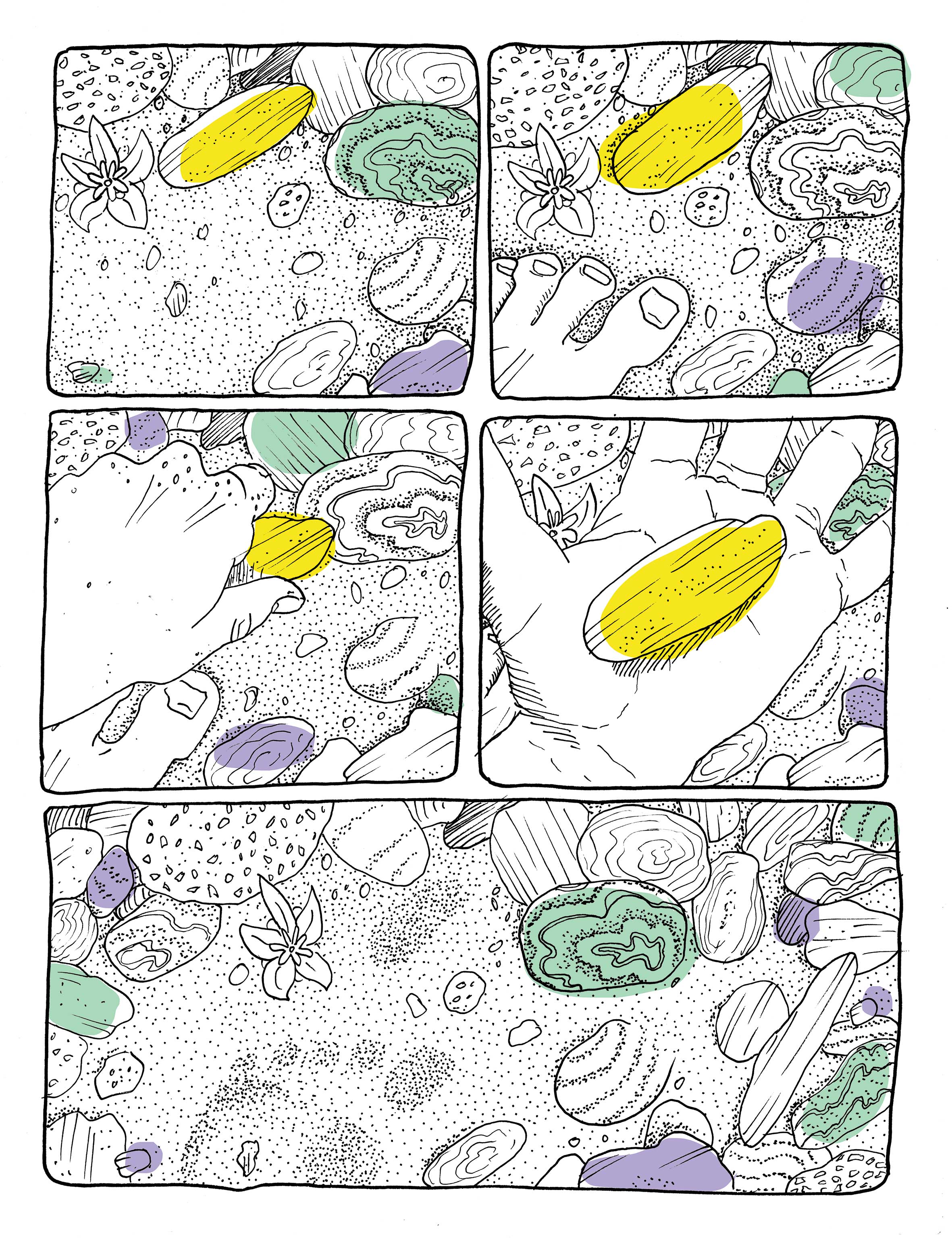
What do you get when you lock up 13 illustrators in a room for a long weekend with the word prompt “Wunderkammer” (cabinet of curiosities), a colour palette, and the aim of putting together an anthology? Here’s my contribution from the weekend, inspired by my own collection of beautiful slender rocks from Lake Baikal.
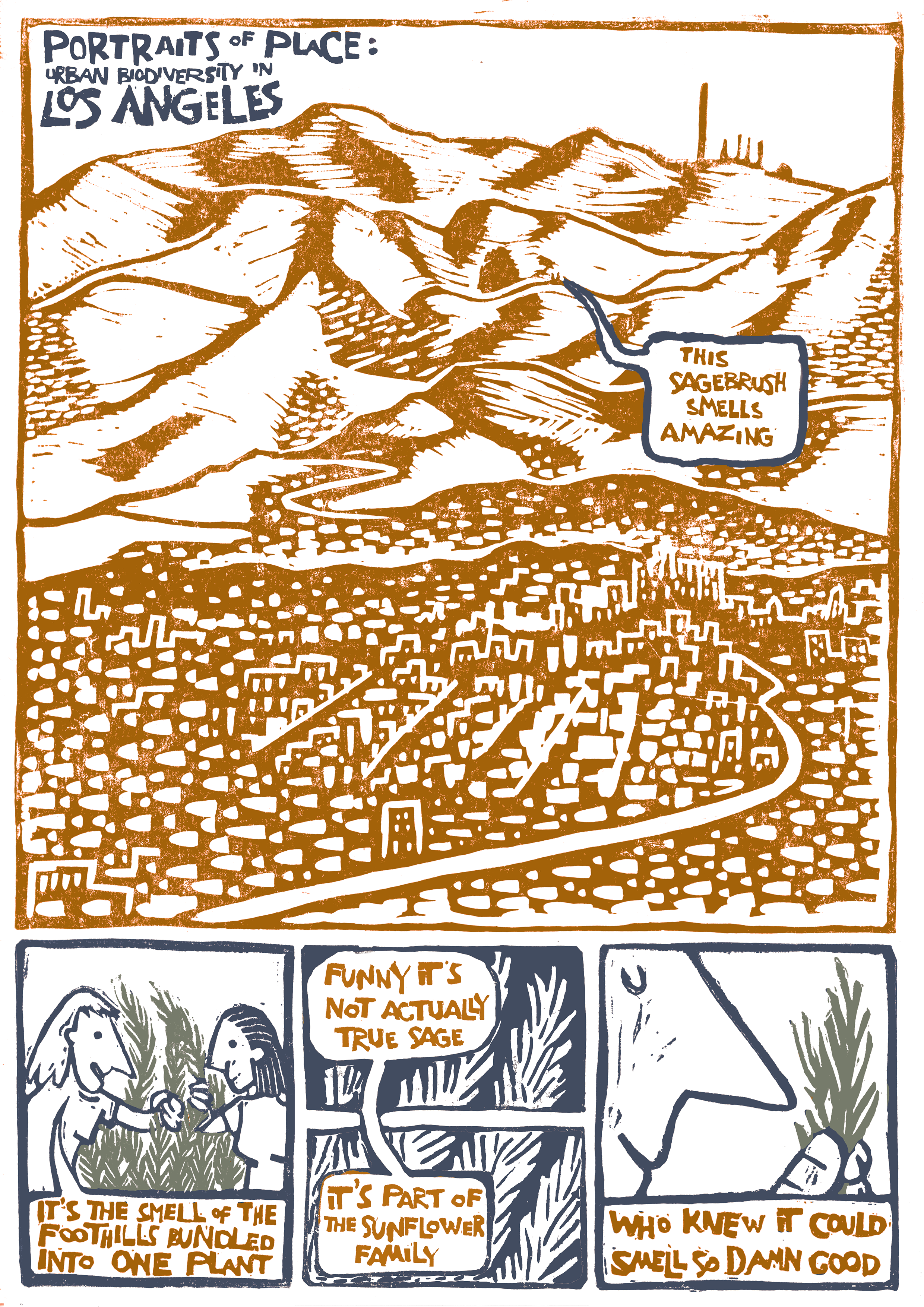
This is the first piece in a series on humans and nature. In this series I explore the in-between spaces, the places where cities spill over into the nature around them, and where nature spills right back into the cities, shaping and influencing them. These places are not wild - they are heavily influenced by humans, through the construction of roads and buildings, the introduction of new species, and the negative impacts of pollution; but equally they are surprisingly rich ecosystems, bastions of nature occupying human spaces. It is these spaces that often host some of the most interesting ecosystems, crazy ecological mishmashes of native and introduced species, which establish themselves amidst pavements and skyscrapers, and which don’t just survive, but in fact thrive within these constraints.
The series will focus primarily on cities, but will also delve into natural spaces that are experiencing human influence, including issues of tourism, pollution, deveopment, and resource extraction.
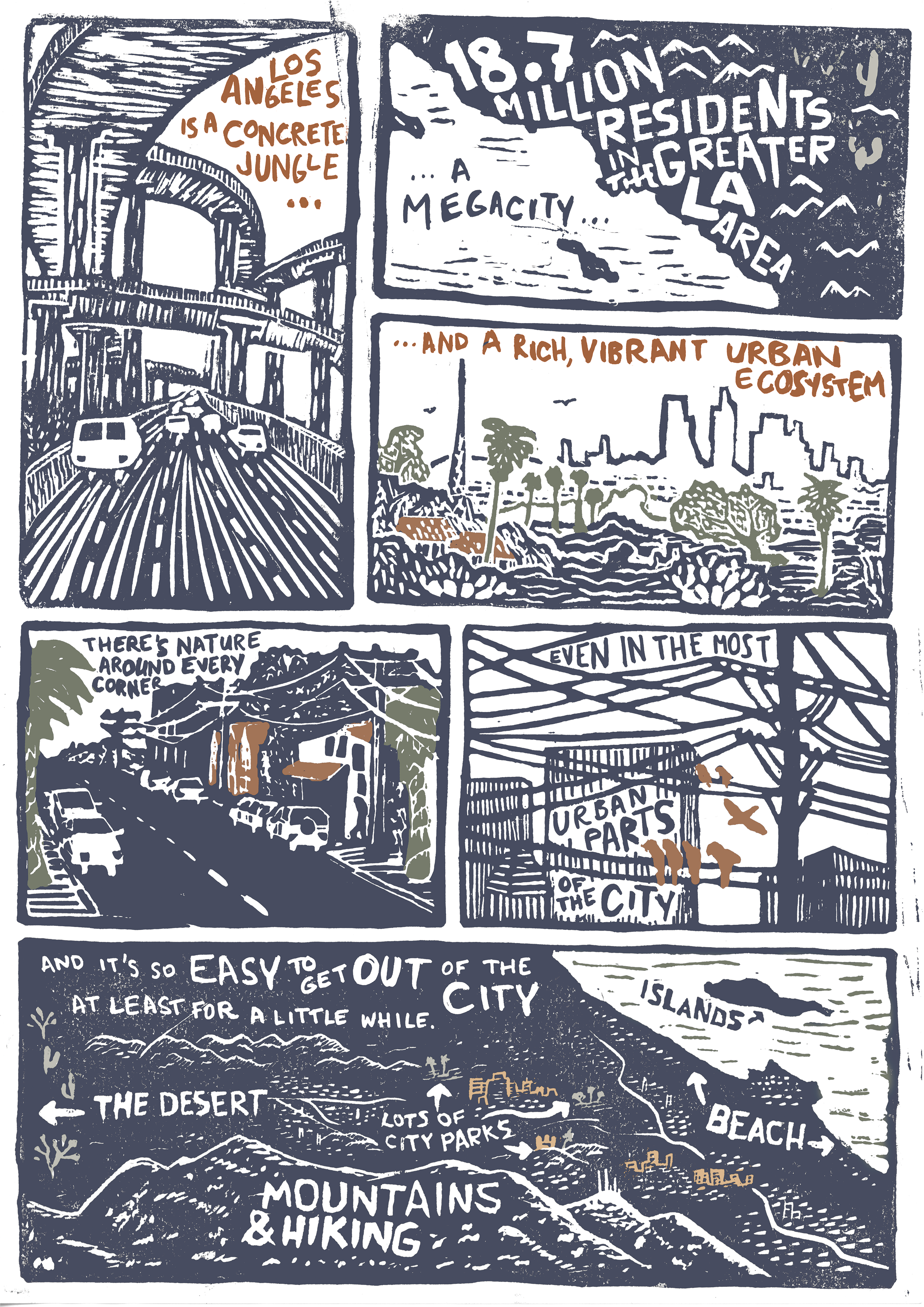
Page 2 in my Portraits of Place series on Los Angeles.

Page 3 in my Portraits of Place series on Los Angeles.

Page 4 in my Portraits of Place series on Los Angeles.
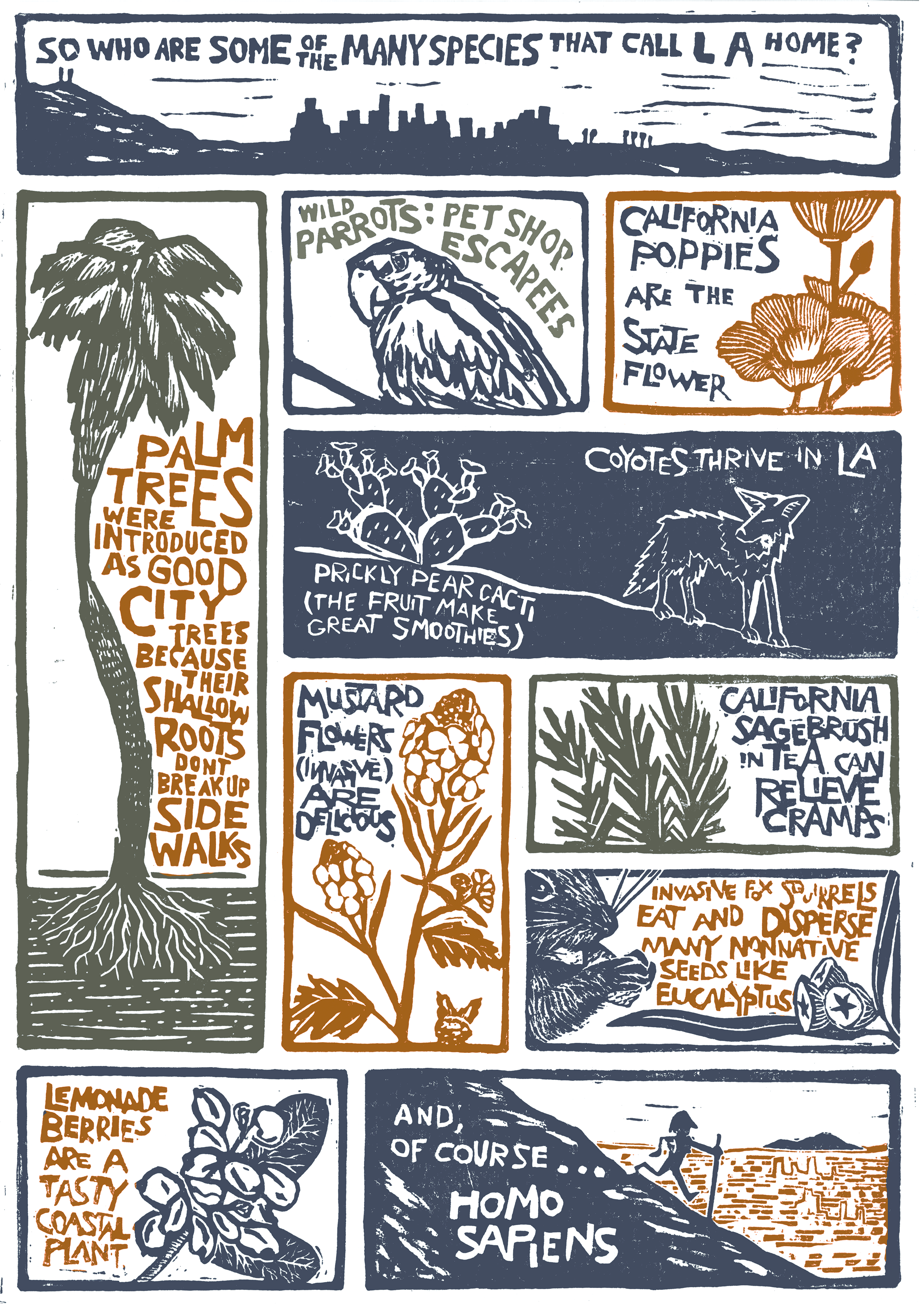
Page 5 in my Portraits of Place series on Los Angeles.

This comic seems to imply that I go running with any kind of regularity. In reality, I sit around and draw about how I ought to go running, and consider that mental exercise to be sufficient.

All about scicomm in the digital age - the topic of my master’s thesis! Social media, blogs, and other online spaces can turn science communication (scicomm) into kind of a ratrace, where fast news and clickbait can seem to overpower more nuanced and informative news and science information. On the flip side, though, online spaces provide platforms for scientists to communicate directly about their work, for science news to reach large audiences, and for science communicators to organise real-life events like science festivals and school visits!
This was for the British Ecological Society’s June Bulletin. I had so much fun drawing me into a comic where I get to talk about something I’m crazy about!

When we talk about dinosaurs, we now divide them into “avian” dinosaurs — the ones that evolved into birds during the Jurassic, and which survived the mass extinction at the end of the Cretaceous — and “non-avian” dinosaurs — the ones who weren’t so lucky. What does that mean? All birds you see today are actually dinosaurs - the avian variety!
This bird here is a Cuban tody which, according to my research, is among the most adorable avian dinosaurs out there (that’s your second bonus fact for the day).




































































This “people’s park noticeboard” of Victoria Park’s history and its role in the local community is based on responses to a survey conducted by Dr. Karen Jones of Kent University (read more here). The questions asked visitors how often they come to Vicky park, how they use the park, what the park means to them, and what they know about its history.
In July 2021, I got to accompany three great workshops at the first Treescapes conference. The workshops were led respectively by Theresa Bodner, Andrew Heald, and Jenny Knight. I got to hop in and out of the different breakout rooms during each workshop, listening to participants’ thoughts and capturing as much as I could! See the images in more detail here.
This series of images was created in collaboration with Dr. Christian Dunn for an online exhibition on Edinburgh’s future green spaces. We envisioned a future in which bogs are featured and celebrated prominently for their important roles in carbon capture and sequestration as well as water filtration. The exhibition was organised by the British Ecological Society in collaboration with the Edinburgh Science Festival and SMASH-UK.
This series of images was created in collaboration with Dr. Christian Dunn for an online exhibition on Edinburgh’s future green spaces. We envisioned a future in which bogs are featured and celebrated prominently for their important roles in carbon capture and sequestration as well as water filtration. The exhibition was organised by the British Ecological Society in collaboration with the Edinburgh Science Festival and SMASH-UK.
This series of images was created in collaboration with Dr. Christian Dunn for an online exhibition on Edinburgh’s future green spaces. We envisioned a future in which bogs are featured and celebrated prominently for their important roles in carbon capture and sequestration as well as water filtration. The exhibition was organised by the British Ecological Society in collaboration with the Edinburgh Science Festival and SMASH-UK.
I’ve been thinking a lot about roots lately as my apartment fills with houseplants. Each one sits in a separate pot and I find myself asking—do they know that there are other plants around them? Or are their communication pathways cut off by virtue of not sharing the same soil—and the same mycorrhizal networks? This comic for the June issue of The Niche explores just what all those mycorrhizal connections do—and what our houseplants might be missing out on!
“When a group of liberal arts students embark on a university assignment about the natural environment, no one could have quite prepared them for the bewildering array of questions and provocations to confront them in their task.
“What starts out as an earnest attempt to understand nature in the modern world, turns into a philosophical and practical tangle that only a good transdisciplinary education can provide. Can anyone save the day and actually start to value ‘nature’? And if they can’t, then what’s stopping them?”
Illustrated together with Rob Fish, this illustrated graphic guide to valuing nature explores the various frameworks—from economic to social to political to philosophical—that we have traditionally used to define and shape our relationship to nature.
I wrote a blog post when we submitted our final manuscript. You can also find more information about the book under the “books” section on my website, as well as on the publisher’s website here.
A piece for Cara Holland’s “Be A Graphic Recorder” course! This one is a graphic translation, or a visualization of a text (rather than a live recording of a talk). I picked a text by Daniel Potter from KQED on eucalyptus trees in California, which describes their introduction in the 1850s, their subsequent boom as plantation trees, and their fall from grace with accusations of being fire hazards (an accusation that is still debated). I for one melt at the sight and smell of eucalyptus; it seems I belong to that subset of people who would say that its smell is as much the smell of southern California as chaparral is. But it, like many introduced species, is a source of strong emotions and much debate. I enjoyed reading the article and creating this graphic—and, in doing so, giving some thought to novel ecosystems, identity of place, and the way in which we love and define our landscapes by the nature they contain, both old and new.
A mini digital graphic recording I did for the “Be A Graphic Recorder Course” with Cara Holland. I picked an episode of the BBC Earth podcast called “Saving a Species Through Sound“, and challenged myself to stick to about 30 minutes (with a Google window open for quick visual references!!).
My piece for The Niche, September 2020. Low on visuals, high on text. There is so much anti-racist work to be done in the name of achieving equality, and it starts by decolonising our fields – ecology included – and working to make them more inclusive. Here is a link to resources to help support petitions, movements, and calls for change as we fight to reaffirm the essential truth that #BlackLivesMatter.
A piece for the June/July edition of The Niche from the British Ecological Society, reflecting on our relationship to nature from inside during quarantine.
I had the opportunity to do the artwork for this poster on carbon accumulation in peatlands for Alice Milner and Andy Baird for the #INQUADUB19 conference. You can find their paper here.
A scicommic I did for Solène Guenat exploring her research on the impacts of urbanisation and greenspace management in two cities in Ghana. You can find the full paper here.
A piece for the March edition of The Niche from the British Ecological Society, touching on the importance of urban nature.
In December 2019 I got to return to my favourite conference of the year – the British Ecological Society (BES) conference, which this year took place in Belfast. I visited sessions on Nature & Humans, Citizen Science, and Harnessing the Data Revolution – a diverse and wonderful range of talks! Check out more of my graphic recording from the event here.
This is a teaser, published in the December issue of The Niche, for an upcoming book that I’m working on in collaboration with Rob Fish from the University of Kent, called “Valuing Nature: The Roots of Transformation”. Stay tuned for more on this book in 2020!
In 2018, a report from the IPCC (International Panel on Climate Change) outlined the impacts that we should expect to see under various warming scenarios. This booklet (68 pages!) takes us on a time-travel adventure into two of those possible futures: a 1,5°C scenario (“in which we managed to save our planet”) and a 3°C scenario (“in which we failed to slow down the climate crisis”). Written by Marie Heitfeld of Germanwatch, it’s intended to engage German speakers of all ages. In addition to the two scenarios, the book includes a middle section that provides tips and recommended actions people can take to reduce their carbon footprint (and to increase their handprint, aka the positive actions that they take).
The book is available to order as a print copy on the Germanwatch website, as well as to download as a PDF as of next week. At this time, it is available only in German.
Illustration for a newspaper produced by RENN.west with layout by Katrin Roth, as part of their campaign “Ziele brauchen Taten” (“Goals require action”). You can find and order the full paper here.
Illustration for a newspaper produced by RENN.west with layout by Katrin Roth, as part of their campaign “Ziele brauchen Taten” (“Goals require action”). You can find and order the full paper here.
Illustration for a newspaper produced by RENN.west with layout by Katrin Roth, as part of their campaign “Ziele brauchen Taten” (“Goals require action”). You can find and order the full paper here.
Illustration for a newspaper produced by RENN.west with layout by Katrin Roth, as part of their campaign “Ziele brauchen Taten” (“Goals require action”). You can find and order the full paper here.
Together with LAG 21 and Germanwatch, I created a series of beer coasters that address the 17 sustainable development goals (SDGs). These are lino print images, coloured digitally, which are juxtaposed next to provocative questions that push us to think about the world we inhabit – and how we can begin to achieve the various SDGs. Get a set here! (nur auf Deutsch | only in German).
Collaboration with RENN.west from August 2019 to create a small pamphlet as part of their campaign “Ziele brauchen Taten” (“Goals require action”) to educate people about the UN’s Sustainable Development Goals. I did both layout and illustration. You can find the pamphlet here.
Collaboration with RENN.west from August 2019 to create a newspaper, a small pamphlet, and a series of drinks coasters as part of their campaign “Ziele brauchen Taten” (“Goals require action”) to educate people about the UN’s Sustainable Development Goals. For the newspaper, I produced a collection of illustrations and small icons, while Katrin Roth did layout (you can find the paper here); and for the pamphlet and drinks coasters I did both layout and illustration (you can find the pamphlet here and the coasters here).
I produced this infographic in collaboration with the Planungsbüro Mordhorst-Bretschneider GmbH, to raise awareness about the impacts of having your dog off-leash out in nature. The top image in a cross-section of Schleswig-Holstein, the state where I live in Germany, with the North Sea on the left and the Baltic Sea on the right. Five ecosystems are summarised, with information about how the presence of off-leash dogs negatively impacts species in each one. This includes stressing migrating birds, scaring ground-nesting fowl away from their nests (which leaves these open to predation), eating or damaging the eggs of ground-nesters, and frightening & stressing deer, sheep and other animals.
You can find the full infographic and pamphlet (in German) here.
An illustration for the September 2019 issue of The Niche, promoting the December meeting in Belfast. I did this over the course of a few days while sitting at a table in a garden in Castagno di Piteccio, Italy, balancing the time between this and painting murals!
In July 2019, I spent two weeks in Castagno di Piteccio, a small outdoor museum of a town perched in the Tuscan hills above Pistoia, Italy. I stayed in a home on the side of the mountain with two other artists, exploring the town, eating well, meeting the wonderful people who live there, and creating art. One family graciously offered me the side of their building to paint, where I created a three-panelled “comic layout” mural with scenes of Castagno. This makes up a further chapter of my “Portraits of Place” series, exploring the identity of place through its ecology.
Photo by the amazing Rachele Salvioli.
In July 2019, I spent two weeks in Castagno di Piteccio, a small outdoor museum of a town perched in the Tuscan hills above Pistoia, Italy. I stayed in a home on the side of the mountain with two other artists, exploring the town, eating well, meeting the wonderful people who live there, and creating art. One family graciously offered me the side of their building to paint, where I created a three-panelled “comic layout” mural with scenes of Castagno. This makes up a further chapter of my “Portraits of Place” series, exploring the identity of place through its ecology.
Photo by the amazing Rachele Salvioli.
In July 2019, I spent two weeks in Castagno di Piteccio, a small outdoor museum of a town perched in the Tuscan hills above Pistoia, Italy. I stayed in a home on the side of the mountain with two other artists, exploring the town, eating well, meeting the wonderful people who live there, and creating art. One family graciously offered me the side of their building to paint, where I created a three-panelled “comic layout” mural with scenes of Castagno. This makes up a further chapter of my “Portraits of Place” series, exploring the identity of place through its ecology.
Another infographic I got to do! This one is for Functional Ecology, a journal from the British Ecological Society, and it is for a special feature on how coral reef functions (including the ecosystem services we derive from them) will continue to evolve as we see further climate and technological change. It includes seven articles, as well as an editorial introducing and summarizing the special feature. You can find the colour-coded articles at the lower left, and see which topics they correspond to in the different parts of the infographic!
.
Find the articles here. Happy reading!
An infographic I did for People and Nature on the economic benefits of managing invasive species. How do we measure how much money we’ve saved by controlling invasive species? Authors Nick Hanley and Michaela Roberts walk us through various methods employed to estimate costs – and costs saved – in their great new article. Find the article here, and the infographic here. Happy reading!
It’s June, which means another comic for The Niche, a quarterly publication from the British Ecological Society! This time I was feeling a marine vibe, so wrote about marine jellyfish and the challenges (and opportunities!) they offer. Jellyfish blooms are increasing in size with factors like warmer weather, which raises the question of whether we can use these blooms (and control them in the process). Currently, an EU-funded research project, GoJelly, is looking into various possibilities: can jellyfish be used to filter microplastics out of water? Can they be used at a wider scale as fertilizer? What about in skin products? And to what extent can we start serving them up on dinner plates here in Europe? These are all exciting possibilities, and an interesting way of looking at challenges as opportunities in a changing ecological landscape.
.
This image was originally published in The Niche, British Ecological Society. 50(2), June 2019: p 9.
Here is an illustration I got to do for Stonecrop Review to accompany a beautiful piece on the mudlarks along the Thames – a community of people who (permits in hand) sift through the mud at the river’s banks in search of the treasures it might yield up. The piece was written by Mackenzie Weinger.
Here is an illustration I got to do for Stonecrop Review to accompany a beautiful piece about childhood memory of place and sense of home, HaOdem 6 by Anna Moritz (find her on Instagram, or see her work on Mental Papercuts).
Another illustration I did for Stonecrop Review’s first issue! This is one of two illustrations (pencil/watercolour/digital) done for Kate Finegan’s piece “Your Own Two Hands”. It’s the opening story in our magazine, capturing the intersection of city and nature through a series of vignettes and portraits of raccoons. The story is rich in details and imagery, and I loved trying to capture as many as possible in this drawing!
One of the illustrations I did for Stonecrop Review’s first issue! This is one of two illustrations (pencil/watercolour/digital) done for Kate Finegan’s piece “Your Own Two Hands”. It’s the opening story in our magazine, capturing the intersection of city and nature through a series of vignettes and portraits of raccoons. The story is rich in details and imagery, and I loved trying to capture as many as possible in this drawing!
This infographic appeared on the People and Nature blog, Relational Thinking, to accompany a plain-language summary of an article published in People and Nature, British Ecological Society. 1(1), March 2019: pp87-102 (read the plain-language summary here).
The article, Effects of climatically shifting species distributions on biocultural relationships (by Matthew Bond, Barbara Anderson, Te Hemo Ata Henare, and Priscilla Wehi) explores how climate change impacts cultural knowledge and human-nature relationships. Specifically, the research examined two plant species used for weaving and medicine by the indigenous Māori people of New Zealand. It looked at how the plants’ ranges will likely shift as a result of climate change, and compared this to where the plants are currently harvested. Although the plants themselves are not threatened by climate change, they will move away from prized harvesting areas! This could have significant impacts on access to the plants, which could in turn impact use of the plants and ultimately lead to loss of traditional knowledge. This article reminds us how important it is to consider impacts like this when studying climate change!
Beavers are back! This comic, all about beaver reintroduction to the UK, is out now in The Niche, the @britishecolsoc’s amazing quarterly magazine. It’s worth becoming a member just to be able to read this magazine, it’s so chock full of wonderful articles on exciting ecology research going on in the world. And as always, I’m so honored to get to be a part of it!
This comic was made in collaboration with @natasha.underwood, to serve as supplementary reading for outreach and education about beaver reintroduction. It’s a reminder of the important role that beavers play in ecosystems. Not only do they create habitat for other animals, their dams can benefit human infrastructure, too, by regulating and diminishing downstream flooding.
.
This comic was originally published in The Niche, British Ecological Society. 50(1), March 2019: p9.
Illustrations for the Kiel University Graduate Center’s brochures. These advertise various course offerings that help graduate students learn better time management, as well as improve their study skills or learn to more effectively communicate and present their research. As always, I am 100% there for anything involving science communication!
Illustrations for the Kiel University Graduate Center’s brochures. These advertise various course offerings that help graduate students learn better time management, as well as improve their study skills or learn to more effectively communicate and present their research. As always, I am 100% there for anything involving science communication!
Illustrations for the Kiel University Graduate Center’s brochures. These advertise various course offerings that help graduate students learn better time management, as well as improve their study skills or learn to more effectively communicate and present their research. As always, I am 100% there for anything involving science communication!
Last July, I spent a week in Palermo, Italy, exploring its green corners and creating a visual portrait of the city’s plants. The week itself was magnificent, and getting to put together this image afterwards felt like revisiting the city’s corners all over again. It felt at once hugely familiar and entirely new. The vegetation in this mediterranean environment is so similar to that in California where I grew up, a reminder of the extent to which we’ve scattered and transported our favourite plants across the globe. And of course, hearing Italian – even if I can’t understand it as well as I used to – reminds me of living in Italy as a teenager, and brings back those familiar emotions of new horizons and overcoming shyness and stumbling forward in new and unfamiliar environments.
This is a continuation of my “Portraits of Place” series, and my decision to use tiles in this piece stemmed from the ubiquitousness of maiolica tiles in Palermo. The tiles both shape and reflect the city, and the images on them provide us with glimpses into the plants of Palermo during the last centuries.
This is an example of some of the graphic recording I did recently at the British Ecological Society’s annual meeting in Birmingham in December 2018. I got to attend multiple sessions and workshops, including this amazing workshop about LEGO serious play (basically getting adults to take off their grown up hats, sit down on the floor in a circle, and get creative! The idea is that it not only sparks creativity, but also, when structured right, creates an inclusive space where everyone has an opportunity to speak up).
Check out the rest of the graphic recording from the conference here!
Another piece for the British Ecological Society’s quarterly bulletin! This one deals with topics within conservation, and the concept of “novel ecosystems”. Are these human-modified ecosystems a valuable resource to be studied and observed? Are they symbols that we’ve allowed old ecosystems to become too modified? Should we attempt to restore old ecosystems? These are big questions that ecologists and conservationists deal with every day, and I think there’s no completely right answer. That said, I am fascinated by the idea of studying modified ecosystems, and observing how nature shapes itself around ongoing human impact.
I recently got asked to do a graphic for a lecture series in Nordrhein-Westfalen on regional sustainability; you can find the graphic in its new home, as well as info about the talks here at the Landesarbeitsgemeinschaft Agenda 21 NRW website. The graphic was a lot of fun to make: it needed to contain agriculture, technology, innovation, demographic change, digitalization, ecology, and sustainable technology and development. The obvious solution? Network nodes, where each node communicated a different topic!
A poster I did to promote a periodic afternoon meeting to discuss all sorts of current topics: from feminism to sustainability to queer issues to social engagement. For those of you in Kiel looking for an interesting space to sit down and talk with other engaged students, check it out!
My contribution to the zine “Grow n’ Pains”, which is compiled by It’s Kinda Okay. I loved thinking about what adulthood means to me, and allowing my recent time in Sweden to influence the visuals for this piece.
This is a piece I did for Split Rock Review’s Autumn issue, exploring humans in nature - expectations, unexpected weather, and finding beauty inside of that! Very much based on a real camping trip on the SHT, which ended up being fabulous despite – and perhaps even because of – all the rain.
This is a piece I did for Split Rock Review’s Autumn issue, exploring humans in nature - expectations, unexpected weather, and finding beauty inside of that! Very much based on a real camping trip on the SHT, which ended up being fabulous despite – and perhaps even because of – all the rain.
An ode to weeds and our complicated human relationship to them, for the British Ecological Society’s September Bulletin.
Recommended reading to accompany this comic: Weeds: How Vagabond Plants Gatecrashed Civilisation and Changed the Way We Think About Nature by Richard Mabey.
What do you get when you lock up 13 illustrators in a room for a long weekend with the word prompt “Wunderkammer” (cabinet of curiosities), a colour palette, and the aim of putting together an anthology? Here’s my contribution from the weekend, inspired by my own collection of beautiful slender rocks from Lake Baikal.
What do you get when you lock up 13 illustrators in a room for a long weekend with the word prompt “Wunderkammer” (cabinet of curiosities), a colour palette, and the aim of putting together an anthology? Here’s my contribution from the weekend, inspired by my own collection of beautiful slender rocks from Lake Baikal.
What do you get when you lock up 13 illustrators in a room for a long weekend with the word prompt “Wunderkammer” (cabinet of curiosities), a colour palette, and the aim of putting together an anthology? Here’s my contribution from the weekend, inspired by my own collection of beautiful slender rocks from Lake Baikal.
What do you get when you lock up 13 illustrators in a room for a long weekend with the word prompt “Wunderkammer” (cabinet of curiosities), a colour palette, and the aim of putting together an anthology? Here’s my contribution from the weekend, inspired by my own collection of beautiful slender rocks from Lake Baikal.
This is the first piece in a series on humans and nature. In this series I explore the in-between spaces, the places where cities spill over into the nature around them, and where nature spills right back into the cities, shaping and influencing them. These places are not wild - they are heavily influenced by humans, through the construction of roads and buildings, the introduction of new species, and the negative impacts of pollution; but equally they are surprisingly rich ecosystems, bastions of nature occupying human spaces. It is these spaces that often host some of the most interesting ecosystems, crazy ecological mishmashes of native and introduced species, which establish themselves amidst pavements and skyscrapers, and which don’t just survive, but in fact thrive within these constraints.
The series will focus primarily on cities, but will also delve into natural spaces that are experiencing human influence, including issues of tourism, pollution, deveopment, and resource extraction.
Page 2 in my Portraits of Place series on Los Angeles.
Page 3 in my Portraits of Place series on Los Angeles.
Page 4 in my Portraits of Place series on Los Angeles.
Page 5 in my Portraits of Place series on Los Angeles.
This comic seems to imply that I go running with any kind of regularity. In reality, I sit around and draw about how I ought to go running, and consider that mental exercise to be sufficient.
All about scicomm in the digital age - the topic of my master’s thesis! Social media, blogs, and other online spaces can turn science communication (scicomm) into kind of a ratrace, where fast news and clickbait can seem to overpower more nuanced and informative news and science information. On the flip side, though, online spaces provide platforms for scientists to communicate directly about their work, for science news to reach large audiences, and for science communicators to organise real-life events like science festivals and school visits!
This was for the British Ecological Society’s June Bulletin. I had so much fun drawing me into a comic where I get to talk about something I’m crazy about!
When we talk about dinosaurs, we now divide them into “avian” dinosaurs — the ones that evolved into birds during the Jurassic, and which survived the mass extinction at the end of the Cretaceous — and “non-avian” dinosaurs — the ones who weren’t so lucky. What does that mean? All birds you see today are actually dinosaurs - the avian variety!
This bird here is a Cuban tody which, according to my research, is among the most adorable avian dinosaurs out there (that’s your second bonus fact for the day).
